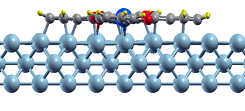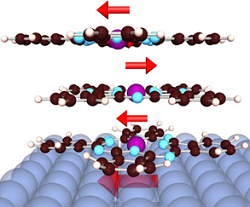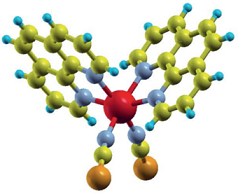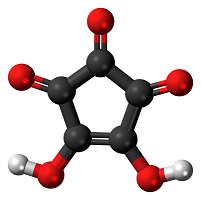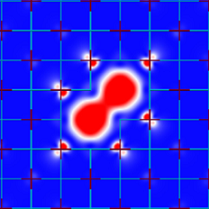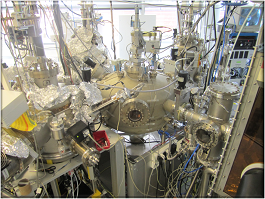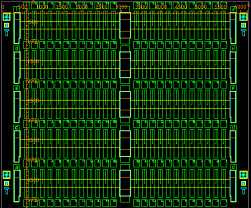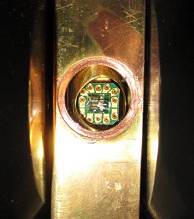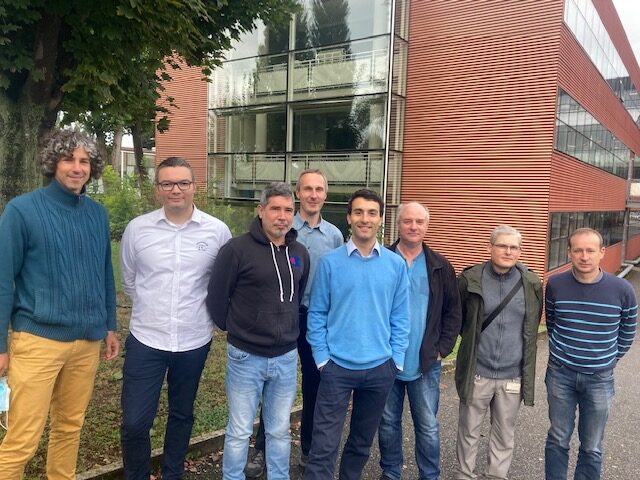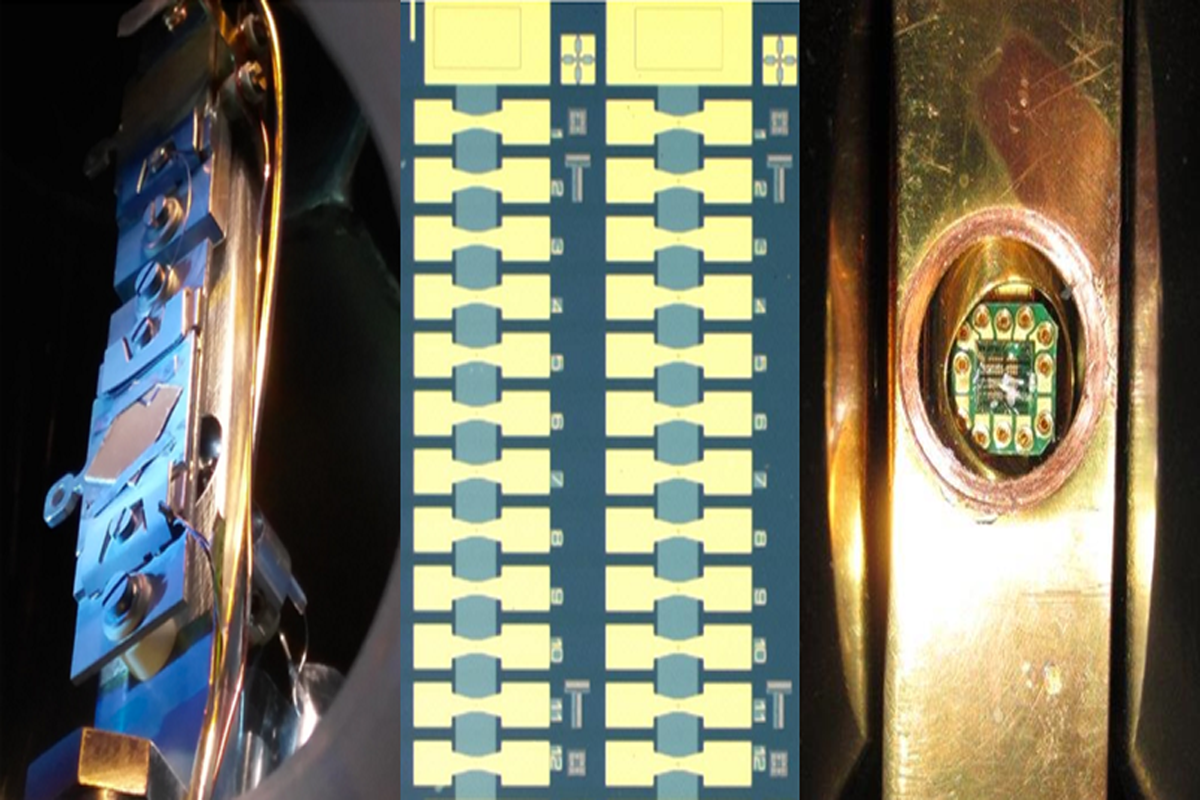Spin electronics, which operates thanks to the quantum electron spin property, can be downscaled to just a few nm and already benefits from industrial penetration in the information and communication technologies (ICT; read heads for hard drives; robust, non-volatile, ultrafast memories ; bio-inspired computing…). Spintronics thus embodies a promising technological axis to implement industrial applications of quantum physics based on the spin and orbital symmetry of the electron.
The ‘Hybrid Spintronics’ team works on integrating quantum nanoobjects within spintronic devices, toward ICT and energy applications (see www.spinengine.tech ). These nanoobjects are functional molecules, or even oxygen vacancies within the device’s tunnel barrier. This requires A) fundamental studies, for example into the emergent properties at the ferromagnetic metal/molecule interface, and B) technical advances beyond the state-of-the-art.
To do so, the team develops and operates an innovative research chain that comprises:
1) tools to grow and characterize metal/molecule heterostructures;the STNano technological platform );in operando .
Research Activities
Multifunctional devices Integrating functional spacers, such as the ferroelectric property of molecules, into spintronic devices is a means of achieving a multifunctional device, i.e. a device whose state (e.g. resistance) depends on a history of external stimuli (electric field, light, temperature, magnetic field, etc…). This targets Information and Communication Technologies.
Energy Harvesting Our team is developping a new method to harvest the thermal fluctuations of ambient temperature using spintronics. Our devices integrate the paramagnetic centers of oxide and molecular compounds into spintronic devices that also comprise electrodes that select a spin channel for transport. This latter feature is accomplished using so-called spinterfaces (see below). See www.spinengine.tech for more details.
In the news
We call on atomic electronic physicists to help deepen our understanding of the quantum spintronic engine. npj Quantum Info. 9, 25 (2023) .
We’ve reproduced our prior observation of spontaneous electrical power output on nine molecular spintronic devices. This ‘quantum spintronic engine’ utilizes magnetic exchange coupling between phthalocyanine molecules, and its strokes can reach ~100THz. A magnetoresistance of 770% is observed — a record for molecular spintronics. Adv. Mater. 34 2206688 (2022) .
We’ve observed the robust reversibility of ferroelectricity in croconic acid molecular films. Nanoscale 13 19466 (2021)
We developed a novel nanotechnological process to study spin-polarized transport across a molecular spin chain within a solid-state device. Electrically exciting the spin chain from its quantum ground state generates a specific magnetoresistance signal. This quantum encoding of information lays the groundwork for information transmission across the spin chain. Adv. Func. Mater. 2009467 (2021). Savoir Magazine
The website www.spinengine.tech describes the concept to spintronically harvest thermal fluctuations to the academic and general publics.
We reported spontaneous electrical power generation from a single spintronic device at room temperature. In this ‘spin engine’, the thermal fluctuations of paramagnetic centers are spintronically harvested. In the process, we demonstrated that the current flowing across the ‘spinterface’ is highly spin-polarized. Commun. Phys., 2 116 (2019). CNRS News. , Unistra News. , www.spinengine.tech
We factually demonstrated that the spin crossover molecular property is involved in electrical transport, thanks to synchrotron-grade in operando experiments. ACS Appl. Mater. & Int., 10 31580 (2018). Soleil Highlight 2018.
We harnessed the chemical selectivity of synchrotron-grade X-ray absorption spectroscopy to probe the active atoms of a device in operation. Adv. Mater., 1606578 (2017) CNRS News
We demonstrated how to electrically modulate the magnetism of the ferromagnet/molecule interface, aka the ‘spinterface’. Adv. Func. Mater., 1700259 (2017). Soleil Highlight 2017 .
We reported the simplest method to achieve a highly spin-polarized current source: create an interface between a ferromagnet and carbon atoms. Carbon 87 , 269 (2015) CNRS News .
Quantum Nano-objects
Molecular spin chains The formation of the spinterface can modify the electronic properties of the metal and molecule constituents. A ferromagnetic metal may see its magnetic anisotropy radically altered . A non-magnetic metal can become magnetic . The magnetization of the molecular interfacial layer can be extended into the molecular film by harnessing magnetic interactions between molecules . This allows the spinterface to stabilize the magnetization of paramagnetic spin chains borne by molecules. Here, we use planar phthalocyanine molecules with a central paramagnetic site. We are studying how to spintronically address the ground and excited states of these spin chains using molecular nanojunctions. These molecules are also used to study the spintronic harvesting of thermal fluctuations .
Spin crossover molecules The central magnetic site of a spin crossover molecule can be switched from a low-spin to a high-spin electronic configuration using external stimuli (light, temperature, electric field…). This makes it a promising candidate to control a spintronic device’s performance. We demonstrated that this molecular functionality is factually involved in transport using a synchrotron-based operando experiment . The next step is to integrate this molecular class into spintronic nanojunctions. To do so, we are leveraging fundamental research (here and here ) on achieving spinterfaces with a noble metal surface so as to not freeze the spin crossover molecular property.
Oxygen vacancies & paramagnetic centers Controlling oxygen vacancies in functional oxides toward next-generation electronics remains challenging. Our team is examining how oxygen vacancies in the ‘simple’ oxide MgO drive the spintronic performance of magnetic tunnel junctions. Our experimental and theoretical results indicate that single and double oxygen vacancies can explain the combination of high spintronic performance, low barrier heights and metallic conduction depending on the junction’s magnetic state. We are examining the impact of these nano-objects on spin-transfer torque, a linchpin physical effect for spintronic technologies. Filling these vacancies with C can promote paramagnetic centers, leading to spintronic energy harvesting .
Experimental Capabilities
Along the research chain: from growth & characterization to device processing to multifunctional measurements
Growth & Characterization Hybrid multichamber cluster
Ultra-high vacuum (UHV) tool to deposit metal, molecules and oxides using sputtering and thermal evaporation. Heterostructure stacks used to make nanojunctions are grown here.
Multiprobe UHV station
Variable temperature Omicron UHV setup to perform local probe techniques (AFM, conducting AFM, MFM, PFM, STM) on surface and bilayers. Basic spinterface studies are performed here. A UHV interconnect with the ‘Hybrid’ is underway.
Spin-polarized electron reflectometry
A UHV setup to probe the spin-polarized electronic properties of single films and heterostructures. Basic spinterface studies are performed here.
Synchrotron techniques
Our team has the expertise to conduct synchrotron beamtime runs in which in-situ grown heterostructures are probed using x-Ray absorption, spin-polarized photoemission and STXM.
Device Processing UV lithography
The team implements a resist- and solvent-based process to craft heterostructures into ~10-micron diameter pillars for magnetotransport measurements. The process is compatible with correlated oxides.
Nanobead processing
Since most molecules may degrade under exposure to solvents and resist, our team has developed a resist- and solvent-free technology that crafts entire heterostructures (thereby preserving UHV-quality interfaces) into vertical nanojunctions. This is a unique capability world-wide.
Multifunctional measurements Multifunctional Bench
Our team has developed an electrical transport bench around a cryo-free cryostat with the following characteristics: T:10-350K, up to H=2T along or at an angle with the sample and the optical axis, cw and ns-pulsed lasers covering 200-2600nm; ns-resolved spectroscopic camera, ns-grade electrical signal/response.
V2TI electrical insert at Beamline DEIMOS, Synchrotron SOLEIL
Our team helped to develop an electrical insert on Beamline DEIMOS, Synchrotron SOLEIL . It is therefore possible to implement the chemical and magnetic sensitivity of X-ray absorption spectroscopy (XAS) on materials subjected to electrical polling (e.g. spinterfaces ), or even on devices in operando .
Prior Memb ers
Eric Beaurepaire, décédé en Avril 2018 .
DJ Kim, Postdoc at U. WarwickIMEC
B. Chowrira, engineer at IMEC
L. Kandpal, postdoc Muduli group , New Delhi
Patents
– 04/2012 : SOURCE DE COURANT POLARISEE EN SPINS WO2013156441A1 .
– 04/2012 : DISPOSITIF INJECTEUR DE SPINS COMPORTANT UNE COUCHE DE PROTECTION EN SON CENTRE WO2013156426A1 .
– 11/2012 : KIT DE CONNEXION D’UN COMPOSANT MICROELECTRONIQUE CONTRE DES DECHARGES ELECTROSTATIQUES LORS DE SA CONNEXION A UN DISPOSITIF CONDUCTEUR WO2014072347 A1 .
– 11/2012 : DISPOSITIF DE POMPAGE, COMPRENANT UN ENSEMBLE DE POMPES EN SERIES ET UN ELEMENT DE COMMUTATION COMMUN WO2014072452A1 .
– 08/2014: PROCESS OF DETECTION OF LIGHT AND ASSOCIATED DEVICE U. Halisdemir, F. Schleicher, S. Boukari, E. Beaurepaire, EP14180354 & EP 2982950 A1 & WO2016020243A1 .
Recent publications :
1839302
TR4ZUX8B
2023
items
1
surface-science-reports
0
author
asc
year
4448
https://www.ipcms.fr/wp-content/plugins/zotpress/
%7B%22status%22%3A%22success%22%2C%22updateneeded%22%3Afalse%2C%22instance%22%3A%22zotpress-f5e2b553cde1e4082862335f36eacd82%22%2C%22meta%22%3A%7B%22request_last%22%3A0%2C%22request_next%22%3A0%2C%22used_cache%22%3Atrue%7D%2C%22data%22%3A%5B%7B%22key%22%3A%22E5DKP73Z%22%2C%22library%22%3A%7B%22id%22%3A1839302%7D%2C%22meta%22%3A%7B%22creatorSummary%22%3A%22Bowen%22%2C%22parsedDate%22%3A%222023%22%2C%22numChildren%22%3A1%7D%2C%22bib%22%3A%22%3Cdiv%20class%3D%5C%22csl-bib-body%5C%22%20style%3D%5C%22line-height%3A%201.35%3B%20%5C%22%3E%5Cn%20%20%3Cdiv%20class%3D%5C%22csl-entry%5C%22%20style%3D%5C%22clear%3A%20left%3B%20%5C%22%3E%5Cn%20%20%20%20%3Cdiv%20class%3D%5C%22csl-left-margin%5C%22%20style%3D%5C%22float%3A%20left%3B%20padding-right%3A%200.5em%3B%20text-align%3A%20right%3B%20width%3A%201em%3B%5C%22%3E%5B1%5D%3C%5C%2Fdiv%3E%3Cdiv%20class%3D%5C%22csl-right-inline%5C%22%20style%3D%5C%22margin%3A%200%20.4em%200%201.5em%3B%5C%22%3EM.%20Bowen%2C%20Atom-level%20electronic%20physicists%20are%20needed%20to%20develop%20practical%20engines%20with%20a%20quantum%20advantage%2C%20NPJ%20Quantum%20Information%209%20%282023%29%201%26%23x2013%3B3.%20%3Ca%20href%3D%27https%3A%5C%2F%5C%2Fdoi.org%5C%2F10.1038%5C%2Fs41534-023-00692-x%27%3Ehttps%3A%5C%2F%5C%2Fdoi.org%5C%2F10.1038%5C%2Fs41534-023-00692-x%3C%5C%2Fa%3E.%3C%5C%2Fdiv%3E%5Cn%20%20%3C%5C%2Fdiv%3E%5Cn%3C%5C%2Fdiv%3E%22%2C%22data%22%3A%7B%22itemType%22%3A%22journalArticle%22%2C%22title%22%3A%22Atom-level%20electronic%20physicists%20are%20needed%20to%20develop%20practical%20engines%20with%20a%20quantum%20advantage%22%2C%22creators%22%3A%5B%7B%22creatorType%22%3A%22author%22%2C%22firstName%22%3A%22Martin%22%2C%22lastName%22%3A%22Bowen%22%7D%5D%2C%22abstractNote%22%3A%22Theoretical%20research%20into%20quantum%20information%20engines%20that%20surpass%20the%20classical%20Carnot%20limit%20has%20exploded%20these%20past%2010%20years%2C%20but%20experiments%20so%20far%20have%20almost%20exclusively%20been%20the%20realm%20of%20the%20optics%20community.%20To%20help%20advance%20the%20field%2C%20and%20to%20develop%20solutions%20that%20might%20help%20our%20energy-dependent%20global%20society%20navigate%20the%20planetary%20crises%2C%20it%27s%20high%20time%20that%20physicists%20working%20on%20atom-level%20electronics%20join%20the%20game.%22%2C%22date%22%3A%222023%22%2C%22language%22%3A%22English%22%2C%22DOI%22%3A%2210.1038%5C%2Fs41534-023-00692-x%22%2C%22ISSN%22%3A%222056-6387%22%2C%22url%22%3A%22http%3A%5C%2F%5C%2Fdx.doi.org%5C%2F10.1038%5C%2Fs41534-023-00692-x%22%2C%22collections%22%3A%5B%22UVN4N32C%22%2C%22TR4ZUX8B%22%5D%2C%22dateModified%22%3A%222023-05-31T13%3A23%3A02Z%22%7D%7D%2C%7B%22key%22%3A%22MZSC3ZED%22%2C%22library%22%3A%7B%22id%22%3A1839302%7D%2C%22meta%22%3A%7B%22creatorSummary%22%3A%22Desbuis%20et%20al.%22%2C%22parsedDate%22%3A%222023%22%2C%22numChildren%22%3A1%7D%2C%22bib%22%3A%22%3Cdiv%20class%3D%5C%22csl-bib-body%5C%22%20style%3D%5C%22line-height%3A%201.35%3B%20%5C%22%3E%5Cn%20%20%3Cdiv%20class%3D%5C%22csl-entry%5C%22%20style%3D%5C%22clear%3A%20left%3B%20%5C%22%3E%5Cn%20%20%20%20%3Cdiv%20class%3D%5C%22csl-left-margin%5C%22%20style%3D%5C%22float%3A%20left%3B%20padding-right%3A%200.5em%3B%20text-align%3A%20right%3B%20width%3A%201em%3B%5C%22%3E%5B1%5D%3C%5C%2Fdiv%3E%3Cdiv%20class%3D%5C%22csl-right-inline%5C%22%20style%3D%5C%22margin%3A%200%20.4em%200%201.5em%3B%5C%22%3EV.%20Desbuis%2C%20D.%20Lacour%2C%20C.%20Tiusan%2C%20W.%20Weber%2C%20M.%20Hehn%2C%20sp-%20and%20d-band%20effects%20on%20secondary%20low-energy%20electron%20generation%2C%20Physical%20Review%20B%20108%20%282023%29%20214424.%20%3Ca%20href%3D%27https%3A%5C%2F%5C%2Fdoi.org%5C%2F10.1103%5C%2FPhysRevB.108.214424%27%3Ehttps%3A%5C%2F%5C%2Fdoi.org%5C%2F10.1103%5C%2FPhysRevB.108.214424%3C%5C%2Fa%3E.%3C%5C%2Fdiv%3E%5Cn%20%20%3C%5C%2Fdiv%3E%5Cn%3C%5C%2Fdiv%3E%22%2C%22data%22%3A%7B%22itemType%22%3A%22journalArticle%22%2C%22title%22%3A%22sp-%20and%20d-band%20effects%20on%20secondary%20low-energy%20electron%20generation%22%2C%22creators%22%3A%5B%7B%22creatorType%22%3A%22author%22%2C%22firstName%22%3A%22V.%22%2C%22lastName%22%3A%22Desbuis%22%7D%2C%7B%22creatorType%22%3A%22author%22%2C%22firstName%22%3A%22D.%22%2C%22lastName%22%3A%22Lacour%22%7D%2C%7B%22creatorType%22%3A%22author%22%2C%22firstName%22%3A%22C.%22%2C%22lastName%22%3A%22Tiusan%22%7D%2C%7B%22creatorType%22%3A%22author%22%2C%22firstName%22%3A%22Wolfgang%22%2C%22lastName%22%3A%22Weber%22%7D%2C%7B%22creatorType%22%3A%22author%22%2C%22firstName%22%3A%22M.%22%2C%22lastName%22%3A%22Hehn%22%7D%5D%2C%22abstractNote%22%3A%22Ballistic%20hot%20electrons%20are%20extracted%20from%20a%20magnetic%20tunnel%20junction%20and%20injected%20into%20a%20metallic%20base%20with%20energies%20ranging%20from%200.65%20to%202.8%20eV.%20The%20energy%20and%20wave%20vector%20analysis%20made%20by%20a%20low%20height%20Si%5C%2FCu%20Schottky%20barrier%20allows%20one%20to%20disentangle%20the%20different%20contributions%20to%20the%20scattering.%20The%20hot%20electrons%20transport%20is%20interpreted%20as%20being%20mainly%20influenced%20by%20inelastic%20scattering.%20An%20explicit%20transport%20model%20reproduces%20our%20measurements%20and%20explains%20them%20as%20resulting%20directly%20from%20an%20electron-electron%20inelastic%20scattering%20process%20related%20to%20the%20sp%20and%20d%20bands%20of%20the%20ferromagnetic%20material%20involved.%22%2C%22date%22%3A%222023%22%2C%22language%22%3A%22English%22%2C%22DOI%22%3A%2210.1103%5C%2FPhysRevB.108.214424%22%2C%22ISSN%22%3A%222469-9950%22%2C%22url%22%3A%22http%3A%5C%2F%5C%2Fdx.doi.org%5C%2F10.1103%5C%2FPhysRevB.108.214424%22%2C%22collections%22%3A%5B%22UVN4N32C%22%2C%22TR4ZUX8B%22%2C%22DSWMHYMG%22%5D%2C%22dateModified%22%3A%222024-03-05T15%3A54%3A45Z%22%7D%7D%5D%7D
1839302
TR4ZUX8B
2022
items
1
surface-science-reports
0
author
asc
year
4448
https://www.ipcms.fr/wp-content/plugins/zotpress/
%7B%22status%22%3A%22success%22%2C%22updateneeded%22%3Afalse%2C%22instance%22%3A%22zotpress-455c0e444bf7d1cc591dbaccbf9f1380%22%2C%22meta%22%3A%7B%22request_last%22%3A0%2C%22request_next%22%3A0%2C%22used_cache%22%3Atrue%7D%2C%22data%22%3A%5B%7B%22key%22%3A%22D5BU96IT%22%2C%22library%22%3A%7B%22id%22%3A1839302%7D%2C%22meta%22%3A%7B%22creatorSummary%22%3A%22Avedissian%20et%20al.%22%2C%22parsedDate%22%3A%222022%22%2C%22numChildren%22%3A1%7D%2C%22bib%22%3A%22%3Cdiv%20class%3D%5C%22csl-bib-body%5C%22%20style%3D%5C%22line-height%3A%201.35%3B%20%5C%22%3E%5Cn%20%20%3Cdiv%20class%3D%5C%22csl-entry%5C%22%20style%3D%5C%22clear%3A%20left%3B%20%5C%22%3E%5Cn%20%20%20%20%3Cdiv%20class%3D%5C%22csl-left-margin%5C%22%20style%3D%5C%22float%3A%20left%3B%20padding-right%3A%200.5em%3B%20text-align%3A%20right%3B%20width%3A%201em%3B%5C%22%3E%5B1%5D%3C%5C%2Fdiv%3E%3Cdiv%20class%3D%5C%22csl-right-inline%5C%22%20style%3D%5C%22margin%3A%200%20.4em%200%201.5em%3B%5C%22%3EG.%20Avedissian%2C%20J.%20Arabski%2C%20J.A.%20Wytko%2C%20J.%20Weiss%2C%20V.%20Papaefthimiou%2C%20G.%20Schmerber%2C%20G.%20Rogez%2C%20E.%20Beaurepaire%2C%20C.%20Meny%2C%20Exchange%20bias%20at%20the%20organic%5C%2Fferromagnet%20interface%20may%20not%20be%20a%20spinterface%20effect%2C%20Applied%20Physics%20Reviews%209%20%282022%29%20011417.%20%3Ca%20href%3D%27https%3A%5C%2F%5C%2Fdoi.org%5C%2F10.1063%5C%2F5.0054524%27%3Ehttps%3A%5C%2F%5C%2Fdoi.org%5C%2F10.1063%5C%2F5.0054524%3C%5C%2Fa%3E.%3C%5C%2Fdiv%3E%5Cn%20%20%3C%5C%2Fdiv%3E%5Cn%3C%5C%2Fdiv%3E%22%2C%22data%22%3A%7B%22itemType%22%3A%22journalArticle%22%2C%22title%22%3A%22Exchange%20bias%20at%20the%20organic%5C%2Fferromagnet%20interface%20may%20not%20be%20a%20spinterface%20effect%22%2C%22creators%22%3A%5B%7B%22creatorType%22%3A%22author%22%2C%22firstName%22%3A%22Garen%22%2C%22lastName%22%3A%22Avedissian%22%7D%2C%7B%22creatorType%22%3A%22author%22%2C%22firstName%22%3A%22Jacek%22%2C%22lastName%22%3A%22Arabski%22%7D%2C%7B%22creatorType%22%3A%22author%22%2C%22firstName%22%3A%22Jennifer%20A.%22%2C%22lastName%22%3A%22Wytko%22%7D%2C%7B%22creatorType%22%3A%22author%22%2C%22firstName%22%3A%22Jean%22%2C%22lastName%22%3A%22Weiss%22%7D%2C%7B%22creatorType%22%3A%22author%22%2C%22firstName%22%3A%22Vasiliki%22%2C%22lastName%22%3A%22Papaefthimiou%22%7D%2C%7B%22creatorType%22%3A%22author%22%2C%22firstName%22%3A%22Guy%22%2C%22lastName%22%3A%22Schmerber%22%7D%2C%7B%22creatorType%22%3A%22author%22%2C%22firstName%22%3A%22Guillaume%22%2C%22lastName%22%3A%22Rogez%22%7D%2C%7B%22creatorType%22%3A%22author%22%2C%22firstName%22%3A%22Eric%22%2C%22lastName%22%3A%22Beaurepaire%22%7D%2C%7B%22creatorType%22%3A%22author%22%2C%22firstName%22%3A%22Christian%22%2C%22lastName%22%3A%22Meny%22%7D%5D%2C%22abstractNote%22%3A%22Exchange%20bias%20is%20a%20physical%20effect%20that%20is%20used%20in%20many%20spintronic%20devices%20like%20magnetic%20read%20heads%2C%20magnetic%20random%20access%20memories%2C%20and%20most%20kinds%20of%20magnetic%20sensors.%20For%20the%20next%20generation%20of%20fully%20organic%20devices%2C%20molecular%20exchange%20bias%2C%20if%20existing%2C%20could%20have%20a%20huge%20impact%20for%20developing%20mechanically%20soft%20and%20environment%20friendly%20devices.%20The%20observation%20of%20molecular%20exchange%20bias%20has%20been%20reported%20recently%20in%20hybrid%20systems%20where%20a%20metallic%20ferromagnet%20is%20exchanged%20biased%20by%20an%20organic%20film%2C%20and%20it%20is%20considered%20to%20be%20a%20spinterface%20effect.%20To%20understand%20this%20effect%2C%20we%20investigate%20if%20the%20molecular%20exchange%20bias%20exists%20in%20Co%5C%2Fmetal%20tetra-phenyl%20porphyrin%20hybrid%20bilayer%20systems.%20The%20molecular%20exchange%20bias%20is%20never%20observed%20when%20the%20samples%20are%20properly%20encapsulated%2C%20and%20when%20the%20exchange%20bias%20is%20eventually%20observed%2C%20it%20is%20not%20a%20spinterface%20effect%2C%20but%20it%20results%20from%20air-driven%20partial%20oxidation%20of%20the%20cobalt%20film%20transforming%20part%20of%20the%20metallic%20cobalt%20into%20a%20cobalt%20oxide%20that%20is%20well%20known%20to%20induce%20exchange%20bias%20effects.%20Surprisingly%2C%20oxidation%20is%20very%20difficult%20to%20prevent%20even%20by%20using%20very%20thick%20metallic%20encapsulating%20layers.%20A%20similar%20effect%20is%20observed%20in%20the%20Co%5C%2Fmetal-phthalocyanine%20bilayer%20system%2C%20showing%20that%20the%20molecular%20exchange%20bias%20is%20not%20a%20spinterface%20effect%20also%20in%20the%20hybrid%20system%20in%20which%20this%20effect%20was%20originally%20discovered.%22%2C%22date%22%3A%222022%22%2C%22language%22%3A%22English%22%2C%22DOI%22%3A%2210.1063%5C%2F5.0054524%22%2C%22ISSN%22%3A%221931-9401%22%2C%22url%22%3A%22http%3A%5C%2F%5C%2Fdx.doi.org%5C%2F10.1063%5C%2F5.0054524%22%2C%22collections%22%3A%5B%22M244N6AF%22%2C%22UVN4N32C%22%2C%22ZN5EITAC%22%2C%22CF4ZI7HM%22%2C%22TR4ZUX8B%22%5D%2C%22dateModified%22%3A%222023-06-15T14%3A49%3A44Z%22%7D%7D%2C%7B%22key%22%3A%22N7AQTDHY%22%2C%22library%22%3A%7B%22id%22%3A1839302%7D%2C%22meta%22%3A%7B%22creatorSummary%22%3A%22Chowrira%20et%20al.%22%2C%22parsedDate%22%3A%222022%22%2C%22numChildren%22%3A1%7D%2C%22bib%22%3A%22%3Cdiv%20class%3D%5C%22csl-bib-body%5C%22%20style%3D%5C%22line-height%3A%201.35%3B%20%5C%22%3E%5Cn%20%20%3Cdiv%20class%3D%5C%22csl-entry%5C%22%20style%3D%5C%22clear%3A%20left%3B%20%5C%22%3E%5Cn%20%20%20%20%3Cdiv%20class%3D%5C%22csl-left-margin%5C%22%20style%3D%5C%22float%3A%20left%3B%20padding-right%3A%200.5em%3B%20text-align%3A%20right%3B%20width%3A%201em%3B%5C%22%3E%5B1%5D%3C%5C%2Fdiv%3E%3Cdiv%20class%3D%5C%22csl-right-inline%5C%22%20style%3D%5C%22margin%3A%200%20.4em%200%201.5em%3B%5C%22%3EB.%20Chowrira%2C%20L.%20Kandpal%2C%20M.%20Lamblin%2C%20F.%20Ngassam%2C%20C.-A.%20Kouakou%2C%20T.%20Zafar%2C%20D.%20Mertz%2C%20B.%20Vileno%2C%20C.%20Kieber%2C%20G.%20Versini%2C%20B.%20Gobaut%2C%20L.%20Joly%2C%20T.%20Fert%26%23xE9%3B%2C%20E.%20Monteblanco%2C%20A.%20Bahouka%2C%20R.%20Bernard%2C%20S.%20Mohapatra%2C%20H.%20Prima%20Garcia%2C%20S.%20Elidrissi%2C%20M.%20Gavara%2C%20E.%20Sternitzky%2C%20V.%20Da%20Costa%2C%20M.%20Hehn%2C%20F.%20Montaigne%2C%20F.%20Choueikani%2C%20P.%20Ohresser%2C%20D.%20Lacour%2C%20W.%20Weber%2C%20S.%20Boukari%2C%20M.%20Alouani%2C%20M.%20Bowen%2C%20Quantum%20Advantage%20in%20a%20Molecular%20Spintronic%20Engine%20that%20Harvests%20Thermal%20Fluctuation%20Energy.%2C%20Advanced%20Materials%20Early%20access%20%282022%29%20e2206688%26%23x2013%3Be2206688.%20%3Ca%20href%3D%27https%3A%5C%2F%5C%2Fdoi.org%5C%2F10.1002%5C%2Fadma.202206688%27%3Ehttps%3A%5C%2F%5C%2Fdoi.org%5C%2F10.1002%5C%2Fadma.202206688%3C%5C%2Fa%3E.%3C%5C%2Fdiv%3E%5Cn%20%20%3C%5C%2Fdiv%3E%5Cn%3C%5C%2Fdiv%3E%22%2C%22data%22%3A%7B%22itemType%22%3A%22journalArticle%22%2C%22title%22%3A%22Quantum%20Advantage%20in%20a%20Molecular%20Spintronic%20Engine%20that%20Harvests%20Thermal%20Fluctuation%20Energy.%22%2C%22creators%22%3A%5B%7B%22creatorType%22%3A%22author%22%2C%22firstName%22%3A%22Bhavishya%22%2C%22lastName%22%3A%22Chowrira%22%7D%2C%7B%22creatorType%22%3A%22author%22%2C%22firstName%22%3A%22Lalit%22%2C%22lastName%22%3A%22Kandpal%22%7D%2C%7B%22creatorType%22%3A%22author%22%2C%22firstName%22%3A%22Mathieu%22%2C%22lastName%22%3A%22Lamblin%22%7D%2C%7B%22creatorType%22%3A%22author%22%2C%22firstName%22%3A%22Franck%22%2C%22lastName%22%3A%22Ngassam%22%7D%2C%7B%22creatorType%22%3A%22author%22%2C%22firstName%22%3A%22Charles-Ambroise%22%2C%22lastName%22%3A%22Kouakou%22%7D%2C%7B%22creatorType%22%3A%22author%22%2C%22firstName%22%3A%22Talha%22%2C%22lastName%22%3A%22Zafar%22%7D%2C%7B%22creatorType%22%3A%22author%22%2C%22firstName%22%3A%22Damien%22%2C%22lastName%22%3A%22Mertz%22%7D%2C%7B%22creatorType%22%3A%22author%22%2C%22firstName%22%3A%22Bertrand%22%2C%22lastName%22%3A%22Vileno%22%7D%2C%7B%22creatorType%22%3A%22author%22%2C%22firstName%22%3A%22Christophe%22%2C%22lastName%22%3A%22Kieber%22%7D%2C%7B%22creatorType%22%3A%22author%22%2C%22firstName%22%3A%22Gilles%22%2C%22lastName%22%3A%22Versini%22%7D%2C%7B%22creatorType%22%3A%22author%22%2C%22firstName%22%3A%22Benoit%22%2C%22lastName%22%3A%22Gobaut%22%7D%2C%7B%22creatorType%22%3A%22author%22%2C%22firstName%22%3A%22Loic%22%2C%22lastName%22%3A%22Joly%22%7D%2C%7B%22creatorType%22%3A%22author%22%2C%22firstName%22%3A%22Tom%22%2C%22lastName%22%3A%22Fert%5Cu00e9%22%7D%2C%7B%22creatorType%22%3A%22author%22%2C%22firstName%22%3A%22Elmer%22%2C%22lastName%22%3A%22Monteblanco%22%7D%2C%7B%22creatorType%22%3A%22author%22%2C%22firstName%22%3A%22Armel%22%2C%22lastName%22%3A%22Bahouka%22%7D%2C%7B%22creatorType%22%3A%22author%22%2C%22firstName%22%3A%22Romain%22%2C%22lastName%22%3A%22Bernard%22%7D%2C%7B%22creatorType%22%3A%22author%22%2C%22firstName%22%3A%22Sambit%22%2C%22lastName%22%3A%22Mohapatra%22%7D%2C%7B%22creatorType%22%3A%22author%22%2C%22firstName%22%3A%22Helena%22%2C%22lastName%22%3A%22Prima%20Garcia%22%7D%2C%7B%22creatorType%22%3A%22author%22%2C%22firstName%22%3A%22Safaa%22%2C%22lastName%22%3A%22Elidrissi%22%7D%2C%7B%22creatorType%22%3A%22author%22%2C%22firstName%22%3A%22Miguel%22%2C%22lastName%22%3A%22Gavara%22%7D%2C%7B%22creatorType%22%3A%22author%22%2C%22firstName%22%3A%22Emmanuel%22%2C%22lastName%22%3A%22Sternitzky%22%7D%2C%7B%22creatorType%22%3A%22author%22%2C%22firstName%22%3A%22Victor%22%2C%22lastName%22%3A%22Da%20Costa%22%7D%2C%7B%22creatorType%22%3A%22author%22%2C%22firstName%22%3A%22Michel%22%2C%22lastName%22%3A%22Hehn%22%7D%2C%7B%22creatorType%22%3A%22author%22%2C%22firstName%22%3A%22Francois%22%2C%22lastName%22%3A%22Montaigne%22%7D%2C%7B%22creatorType%22%3A%22author%22%2C%22firstName%22%3A%22Fadi%22%2C%22lastName%22%3A%22Choueikani%22%7D%2C%7B%22creatorType%22%3A%22author%22%2C%22firstName%22%3A%22Philippe%22%2C%22lastName%22%3A%22Ohresser%22%7D%2C%7B%22creatorType%22%3A%22author%22%2C%22firstName%22%3A%22Daniel%22%2C%22lastName%22%3A%22Lacour%22%7D%2C%7B%22creatorType%22%3A%22author%22%2C%22firstName%22%3A%22Wolfgang%22%2C%22lastName%22%3A%22Weber%22%7D%2C%7B%22creatorType%22%3A%22author%22%2C%22firstName%22%3A%22Samy%22%2C%22lastName%22%3A%22Boukari%22%7D%2C%7B%22creatorType%22%3A%22author%22%2C%22firstName%22%3A%22Mebarek%22%2C%22lastName%22%3A%22Alouani%22%7D%2C%7B%22creatorType%22%3A%22author%22%2C%22firstName%22%3A%22Martin%22%2C%22lastName%22%3A%22Bowen%22%7D%5D%2C%22abstractNote%22%3A%22Recent%20theory%20and%20experiments%20have%20showcased%20how%20to%20harness%20quantum%20mechanics%20to%20assemble%20heat%5C%2Finformation%20engines%20with%20efficiencies%20that%20surpass%20the%20classical%20Carnot%20limit.%20So%20far%2C%20this%20has%20required%20atomic%20engines%20that%20are%20driven%20by%20cumbersome%20external%20electromagnetic%20sources.%20Here%2C%20using%20molecular%20spintronics%2C%20an%20implementation%20that%20is%20both%20electronic%20and%20autonomous%20is%20proposed.%20The%20spintronic%20quantum%20engine%20heuristically%20deploys%20several%20known%20quantum%20assets%20by%20having%20a%20chain%20of%20spin%20qubits%20formed%20by%20the%20paramagnetic%20Co%20center%20of%20phthalocyanine%20%28Pc%29%20molecules%20electronically%20interact%20with%20electron-spin-selecting%20Fe%5C%2FC60%20interfaces.%20Density%20functional%20calculations%20reveal%20that%20transport%20fluctuations%20across%20the%20interface%20can%20stabilize%20spin%20coherence%20on%20the%20Co%20paramagnetic%20centers%2C%20which%20host%20spin%20flip%20processes.%20Across%20vertical%20molecular%20nanodevices%2C%20enduring%20dc%20current%20generation%2C%20output%20power%20above%20room%20temperature%2C%20two%20quantum%20thermodynamical%20signatures%20of%20the%20engine%27s%20processes%2C%20and%20a%20record%2089%25%20spin%20polarization%20of%20current%20across%20the%20Fe%5C%2FC60%20interface%20are%20measured.%20It%20is%20crucially%20this%20electron%20spin%20selection%20that%20forces%2C%20through%20demonic%20feedback%20and%20control%2C%20charge%20current%20to%20flow%20against%20the%20built-in%20potential%20barrier.%20Further%20research%20into%20spintronic%20quantum%20engines%2C%20insight%20into%20the%20quantum%20information%20processes%20within%20spintronic%20technologies%2C%20and%20retooling%20the%20spintronic-based%20information%20technology%20chain%2C%20can%20help%20accelerate%20the%20transition%20to%20clean%20energy.%22%2C%22date%22%3A%222022%22%2C%22language%22%3A%22English%22%2C%22DOI%22%3A%2210.1002%5C%2Fadma.202206688%22%2C%22ISSN%22%3A%221521-4095%22%2C%22url%22%3A%22http%3A%5C%2F%5C%2Fdx.doi.org%5C%2F10.1002%5C%2Fadma.202206688%22%2C%22collections%22%3A%5B%22CHW2VGSR%22%2C%22DEB5KWFS%22%2C%22MKAFAH44%22%2C%22QK933HES%22%2C%22UVN4N32C%22%2C%22ZN5EITAC%22%2C%222A2F8AAB%22%2C%226IWM732K%22%2C%22CF4ZI7HM%22%2C%22TBP4QFHK%22%2C%22TR4ZUX8B%22%2C%22UBUT97QT%22%5D%2C%22dateModified%22%3A%222023-02-15T16%3A13%3A24Z%22%7D%7D%2C%7B%22key%22%3A%229KKJPJUL%22%2C%22library%22%3A%7B%22id%22%3A1839302%7D%2C%22meta%22%3A%7B%22creatorSummary%22%3A%22Mohapatra%20et%20al.%22%2C%22parsedDate%22%3A%222022%22%2C%22numChildren%22%3A1%7D%2C%22bib%22%3A%22%3Cdiv%20class%3D%5C%22csl-bib-body%5C%22%20style%3D%5C%22line-height%3A%201.35%3B%20%5C%22%3E%5Cn%20%20%3Cdiv%20class%3D%5C%22csl-entry%5C%22%20style%3D%5C%22clear%3A%20left%3B%20%5C%22%3E%5Cn%20%20%20%20%3Cdiv%20class%3D%5C%22csl-left-margin%5C%22%20style%3D%5C%22float%3A%20left%3B%20padding-right%3A%200.5em%3B%20text-align%3A%20right%3B%20width%3A%201em%3B%5C%22%3E%5B1%5D%3C%5C%2Fdiv%3E%3Cdiv%20class%3D%5C%22csl-right-inline%5C%22%20style%3D%5C%22margin%3A%200%20.4em%200%201.5em%3B%5C%22%3ES.%20Mohapatra%2C%20S.%20Cherifi-Hertel%2C%20S.K.%20Kuppusamy%2C%20G.%20Schmerber%2C%20J.%20Arabski%2C%20B.%20Gobaut%2C%20W.%20Weber%2C%20M.%20Bowen%2C%20V.%20Da%20Costa%2C%20S.%20Boukari%2C%20Organic%20ferroelectric%20croconic%20acid%3A%20a%20concise%20survey%20from%20bulk%20single%20crystals%20to%20thin%20films%2C%20Journal%20of%20Materials%20Chemistry%20C%2010%20%282022%29%208142%26%23x2013%3B8167.%20%3Ca%20href%3D%27https%3A%5C%2F%5C%2Fdoi.org%5C%2F10.1039%5C%2FD1TC05310H%27%3Ehttps%3A%5C%2F%5C%2Fdoi.org%5C%2F10.1039%5C%2FD1TC05310H%3C%5C%2Fa%3E.%3C%5C%2Fdiv%3E%5Cn%20%20%3C%5C%2Fdiv%3E%5Cn%3C%5C%2Fdiv%3E%22%2C%22data%22%3A%7B%22itemType%22%3A%22journalArticle%22%2C%22title%22%3A%22Organic%20ferroelectric%20croconic%20acid%3A%20a%20concise%20survey%20from%20bulk%20single%20crystals%20to%20thin%20films%22%2C%22creators%22%3A%5B%7B%22creatorType%22%3A%22author%22%2C%22firstName%22%3A%22Sambit%22%2C%22lastName%22%3A%22Mohapatra%22%7D%2C%7B%22creatorType%22%3A%22author%22%2C%22firstName%22%3A%22Salia%22%2C%22lastName%22%3A%22Cherifi-Hertel%22%7D%2C%7B%22creatorType%22%3A%22author%22%2C%22firstName%22%3A%22Senthil%20Kumar%22%2C%22lastName%22%3A%22Kuppusamy%22%7D%2C%7B%22creatorType%22%3A%22author%22%2C%22firstName%22%3A%22Guy%22%2C%22lastName%22%3A%22Schmerber%22%7D%2C%7B%22creatorType%22%3A%22author%22%2C%22firstName%22%3A%22Jacek%22%2C%22lastName%22%3A%22Arabski%22%7D%2C%7B%22creatorType%22%3A%22author%22%2C%22firstName%22%3A%22Beno%5Cu00eet%22%2C%22lastName%22%3A%22Gobaut%22%7D%2C%7B%22creatorType%22%3A%22author%22%2C%22firstName%22%3A%22Wolfgang%22%2C%22lastName%22%3A%22Weber%22%7D%2C%7B%22creatorType%22%3A%22author%22%2C%22firstName%22%3A%22Martin%22%2C%22lastName%22%3A%22Bowen%22%7D%2C%7B%22creatorType%22%3A%22author%22%2C%22firstName%22%3A%22Victor%22%2C%22lastName%22%3A%22Da%20Costa%22%7D%2C%7B%22creatorType%22%3A%22author%22%2C%22firstName%22%3A%22Samy%22%2C%22lastName%22%3A%22Boukari%22%7D%5D%2C%22abstractNote%22%3A%22Owing%20to%20prospective%20energy-efficient%20and%20environmentally%20benign%20applications%2C%20organic%20ferroelectric%20materials%20are%20useful%20and%20necessary%20alternatives%20to%20inorganic%20ferroelectrics.%20Although%20the%20first%20discovered%20ferroelectric%2C%20Rochelle%20salt%2C%20was%20a%20salt%20of%20an%20organic%20compound%2C%20organic%20ferroelectrics%20have%20not%20been%20as%20abundant%20as%20the%20inorganic%20ones.%20Furthermore%2C%20the%20small%20polarization%20values%20in%20the%20organic%20systems%20discovered%20so%20far%20have%20been%20a%20demotivating%20factor%20for%20their%20applications.%20However%2C%20scientific%20interest%20and%20activities%20surrounding%20such%20materials%2C%20for%20the%20purpose%20of%20fundamental%20understanding%20and%20practical%20applications%2C%20have%20significantly%20risen%20lately%2C%20especially%20after%20the%20discovery%20of%20above-room-temperature%20ferroelectricity%20in%20croconic%20acid%20%284%2C5-dihydroxy-4-cyclopentene-1%2C2%2C3-trione%2C%20H2C5O5%29%20crystals%20with%20polarization%20values%20rivalling%20those%20found%20in%20inorganic%20ferroelectrics.%20Its%20large%20polarization%2C%20organic%20nature%2C%20and%20vacuum%20sublimability%20make%20croconic%20acid%20an%20ideal%20candidate%20for%20non-toxic%20and%20lead-free%20device%20applications.%20In%20this%20review%20article%2C%20we%20survey%20the%20scientific%20activities%20carried%20out%20so%20far%20involving%20ferroelectricity%20in%20this%20novel%20material%2C%20paying%20equal%20attention%20to%20its%20bulk%20single%20crystal%20and%20thin%20film%20forms.%20While%20we%20discuss%20about%20the%20origin%20of%20ferroelectric%20order%20and%20the%20reversal%20of%20polarization%20in%20the%20bulk%20form%2C%20we%20also%20summarize%20the%20directions%20toward%20applications%20of%20the%20thin%20films.%22%2C%22date%22%3A%222022%22%2C%22language%22%3A%22English%22%2C%22DOI%22%3A%2210.1039%5C%2FD1TC05310H%22%2C%22ISSN%22%3A%22%22%2C%22url%22%3A%22http%3A%5C%2F%5C%2Fdx.doi.org%5C%2F10.1039%5C%2FD1TC05310H%22%2C%22collections%22%3A%5B%22DEB5KWFS%22%2C%22MKAFAH44%22%2C%22UVN4N32C%22%2C%22ZN5EITAC%22%2C%22TR4ZUX8B%22%5D%2C%22dateModified%22%3A%222022-06-28T07%3A40%3A43Z%22%7D%7D%2C%7B%22key%22%3A%22AZW6KZYX%22%2C%22library%22%3A%7B%22id%22%3A1839302%7D%2C%22meta%22%3A%7B%22creatorSummary%22%3A%22Mohapatra%20et%20al.%22%2C%22parsedDate%22%3A%222022%22%2C%22numChildren%22%3A1%7D%2C%22bib%22%3A%22%3Cdiv%20class%3D%5C%22csl-bib-body%5C%22%20style%3D%5C%22line-height%3A%201.35%3B%20%5C%22%3E%5Cn%20%20%3Cdiv%20class%3D%5C%22csl-entry%5C%22%20style%3D%5C%22clear%3A%20left%3B%20%5C%22%3E%5Cn%20%20%20%20%3Cdiv%20class%3D%5C%22csl-left-margin%5C%22%20style%3D%5C%22float%3A%20left%3B%20padding-right%3A%200.5em%3B%20text-align%3A%20right%3B%20width%3A%201em%3B%5C%22%3E%5B1%5D%3C%5C%2Fdiv%3E%3Cdiv%20class%3D%5C%22csl-right-inline%5C%22%20style%3D%5C%22margin%3A%200%20.4em%200%201.5em%3B%5C%22%3ES.%20Mohapatra%2C%20W.%20Weber%2C%20M.%20Bowen%2C%20S.%20Boukari%2C%20V.%20Da%20Costa%2C%20Toward%20accurate%20ferroelectric%20polarization%20estimation%20in%20nanoscopic%20systems%2C%20Journal%20of%20Applied%20Physics%20132%20%282022%29%20134101.%20%3Ca%20href%3D%27https%3A%5C%2F%5C%2Fdoi.org%5C%2F10.1063%5C%2F5.0102920%27%3Ehttps%3A%5C%2F%5C%2Fdoi.org%5C%2F10.1063%5C%2F5.0102920%3C%5C%2Fa%3E.%3C%5C%2Fdiv%3E%5Cn%20%20%3C%5C%2Fdiv%3E%5Cn%3C%5C%2Fdiv%3E%22%2C%22data%22%3A%7B%22itemType%22%3A%22journalArticle%22%2C%22title%22%3A%22Toward%20accurate%20ferroelectric%20polarization%20estimation%20in%20nanoscopic%20systems%22%2C%22creators%22%3A%5B%7B%22creatorType%22%3A%22author%22%2C%22firstName%22%3A%22Sambit%22%2C%22lastName%22%3A%22Mohapatra%22%7D%2C%7B%22creatorType%22%3A%22author%22%2C%22firstName%22%3A%22Wolfgang%22%2C%22lastName%22%3A%22Weber%22%7D%2C%7B%22creatorType%22%3A%22author%22%2C%22firstName%22%3A%22Martin%22%2C%22lastName%22%3A%22Bowen%22%7D%2C%7B%22creatorType%22%3A%22author%22%2C%22firstName%22%3A%22Samy%22%2C%22lastName%22%3A%22Boukari%22%7D%2C%7B%22creatorType%22%3A%22author%22%2C%22firstName%22%3A%22Victor%22%2C%22lastName%22%3A%22Da%20Costa%22%7D%5D%2C%22abstractNote%22%3A%22The%20nanoscopic%20characterization%20of%20ferroelectric%20thin%20films%20is%20crucial%20from%20their%20device%20application%20point%20of%20view.%20Standard%20characterization%20techniques%20are%20based%20on%20detecting%20the%20nanoscopic%20charge%20compensation%20current%20%28switching%20current%29%20caused%20by%20the%20polarization%20reversal%20in%20the%20ferroelectric.%20Owing%20to%20various%20surface%20and%20bulk%20limited%20mechanisms%2C%20leakage%20currents%20commonly%20appear%20during%20such%20measurements%2C%20which%20are%20frequently%20subtracted%20using%20the%20device%20I-V%20characteristic%20by%20employing%20a%20positive-up-negative-down%20measurement%20scheme.%20By%20performing%20nanoscopic%20switching%20current%20measurements%20on%20a%20commonly%20used%20ferroelectric%2C%20BiFeO3%2C%20we%20show%20that%20such%20characterization%20methods%20may%20be%20prone%20to%20large%20errors%20in%20polarization%20estimation%20on%20ferro-resistive%20samples%20due%20to%20current%20background%20subtraction%20issues.%20Specifically%2C%20when%20the%20resistance%20of%20the%20ferroelectric%20thin%20film%20is%20associated%20with%20polarization%20reversal%2C%20background%20current%20subtraction%20is%20not%20accurate%20due%20to%20the%20mismatch%20of%20the%20I-V%20characteristics%20for%20two%20polarization%20states.%20We%20show%20instead%20that%20removing%20the%20background%20current%20by%20an%20asymmetric%20least-squares%20subtraction%20method%2C%20though%20not%20perfect%2C%20gives%20a%20much%20better%20estimation%20of%20the%20ferroelectric%20properties%20of%20the%20sample%20under%20study.%20Published%20under%20an%20exclusive%20license%20by%20AIP%20Publishing.%22%2C%22date%22%3A%222022%22%2C%22language%22%3A%22English%22%2C%22DOI%22%3A%2210.1063%5C%2F5.0102920%22%2C%22ISSN%22%3A%220021-8979%22%2C%22url%22%3A%22http%3A%5C%2F%5C%2Fdx.doi.org%5C%2F10.1063%5C%2F5.0102920%22%2C%22collections%22%3A%5B%22UVN4N32C%22%2C%22TR4ZUX8B%22%5D%2C%22dateModified%22%3A%222023-01-05T10%3A17%3A39Z%22%7D%7D%2C%7B%22key%22%3A%22L68CUGMJ%22%2C%22library%22%3A%7B%22id%22%3A1839302%7D%2C%22meta%22%3A%7B%22creatorSummary%22%3A%22Weng%20et%20al.%22%2C%22parsedDate%22%3A%222022%22%2C%22numChildren%22%3A1%7D%2C%22bib%22%3A%22%3Cdiv%20class%3D%5C%22csl-bib-body%5C%22%20style%3D%5C%22line-height%3A%201.35%3B%20%5C%22%3E%5Cn%20%20%3Cdiv%20class%3D%5C%22csl-entry%5C%22%20style%3D%5C%22clear%3A%20left%3B%20%5C%22%3E%5Cn%20%20%20%20%3Cdiv%20class%3D%5C%22csl-left-margin%5C%22%20style%3D%5C%22float%3A%20left%3B%20padding-right%3A%200.5em%3B%20text-align%3A%20right%3B%20width%3A%201em%3B%5C%22%3E%5B1%5D%3C%5C%2Fdiv%3E%3Cdiv%20class%3D%5C%22csl-right-inline%5C%22%20style%3D%5C%22margin%3A%200%20.4em%200%201.5em%3B%5C%22%3EX.%20Weng%2C%20M.%20Hennes%2C%20A.%20Juhin%2C%20P.%20Sainctavit%2C%20B.%20Gobaut%2C%20E.%20Otero%2C%20F.%20Choueikani%2C%20P.%20Ohresser%2C%20T.%20Tran%2C%20D.%20Hrabovsky%2C%20D.%20Demaille%2C%20Y.%20Zheng%2C%20F.%20Vidal%2C%20Strain-engineering%20of%20magnetic%20anisotropy%20in%20CoxNi1-x-SrTiO3%5C%2FSrTiO3%28001%29%20vertically%20assembled%20nanocomposites%2C%20Physical%20Review%20Materials%206%20%282022%29%20046001.%20%3Ca%20href%3D%27https%3A%5C%2F%5C%2Fdoi.org%5C%2F10.1103%5C%2FPhysRevMaterials.6.046001%27%3Ehttps%3A%5C%2F%5C%2Fdoi.org%5C%2F10.1103%5C%2FPhysRevMaterials.6.046001%3C%5C%2Fa%3E.%3C%5C%2Fdiv%3E%5Cn%20%20%3C%5C%2Fdiv%3E%5Cn%3C%5C%2Fdiv%3E%22%2C%22data%22%3A%7B%22itemType%22%3A%22journalArticle%22%2C%22title%22%3A%22Strain-engineering%20of%20magnetic%20anisotropy%20in%20CoxNi1-x-SrTiO3%5C%2FSrTiO3%28001%29%20vertically%20assembled%20nanocomposites%22%2C%22creators%22%3A%5B%7B%22creatorType%22%3A%22author%22%2C%22firstName%22%3A%22Xiaorong%22%2C%22lastName%22%3A%22Weng%22%7D%2C%7B%22creatorType%22%3A%22author%22%2C%22firstName%22%3A%22Marcel%22%2C%22lastName%22%3A%22Hennes%22%7D%2C%7B%22creatorType%22%3A%22author%22%2C%22firstName%22%3A%22Amelie%22%2C%22lastName%22%3A%22Juhin%22%7D%2C%7B%22creatorType%22%3A%22author%22%2C%22firstName%22%3A%22Philippe%22%2C%22lastName%22%3A%22Sainctavit%22%7D%2C%7B%22creatorType%22%3A%22author%22%2C%22firstName%22%3A%22Benoit%22%2C%22lastName%22%3A%22Gobaut%22%7D%2C%7B%22creatorType%22%3A%22author%22%2C%22firstName%22%3A%22Edwige%22%2C%22lastName%22%3A%22Otero%22%7D%2C%7B%22creatorType%22%3A%22author%22%2C%22firstName%22%3A%22Fadi%22%2C%22lastName%22%3A%22Choueikani%22%7D%2C%7B%22creatorType%22%3A%22author%22%2C%22firstName%22%3A%22Philippe%22%2C%22lastName%22%3A%22Ohresser%22%7D%2C%7B%22creatorType%22%3A%22author%22%2C%22firstName%22%3A%22Thomas%22%2C%22lastName%22%3A%22Tran%22%7D%2C%7B%22creatorType%22%3A%22author%22%2C%22firstName%22%3A%22David%22%2C%22lastName%22%3A%22Hrabovsky%22%7D%2C%7B%22creatorType%22%3A%22author%22%2C%22firstName%22%3A%22Dominique%22%2C%22lastName%22%3A%22Demaille%22%7D%2C%7B%22creatorType%22%3A%22author%22%2C%22firstName%22%3A%22Yunlin%22%2C%22lastName%22%3A%22Zheng%22%7D%2C%7B%22creatorType%22%3A%22author%22%2C%22firstName%22%3A%22Franck%22%2C%22lastName%22%3A%22Vidal%22%7D%5D%2C%22abstractNote%22%3A%22Ultrathin%20CoxNi1-x%20alloy%20nanowires%20vertically%20embedded%20in%20SrTiO3%5C%2FSrTiO3%20%28001%29%20thin%20films%20were%20grown%20using%20a%20self-assembly%20approach%20based%20on%20sequential%20pulsed%20laser%20deposition.%20Due%20to%20vertical%20epitaxial%20coupling%20of%20the%20metallic%20and%20oxide%20phases%2C%20a%20large%20average%20tensile%20strain%20of%20up%20to%204%25%20arises%20within%20the%20nanowires%2C%20which%20is%20evidenced%20using%20a%20combination%20of%20x-ray%20diffraction%20and%20transmission%20electron%20microscopy.%20Macroscopic%20magnetometry%20experiments%20are%20used%20to%20demonstrate%20that%20this%20huge%20deformation%20allows%20us%20to%20enhance%20the%20uniaxial%20anisotropy%20of%20the%20nanowires%2C%20leading%20to%20saturation%20field%20in%20excess%20of%201%20T%20in%20the%20hard%20direction%2C%20large%20coercive%20field%20at%20low%20temperature%20along%20the%20easy%20axis%2C%20and%20to%20a%20blocking%20temperature%20exceeding%20600%20K%20in%20the%20case%20of%20nanowires%20with%20a%20diameter%20of%205%20nm%20and%2078%25%20Co%20content.%20These%20data%20are%20complemented%20with%20angular%20dependent%20x-ray%20magnetic%20circular%20dichroism%20measurements%20at%20the%20Co%20and%20Ni%20L-2%2CL-3%20edges.%20The%20value%20of%20the%20magnetic%20moment%20was%20extracted%20from%20these%20measurements%20by%20applying%20sum%20rules%20and%20the%20anisotropy%20of%20the%20orbital%20moment%20was%20investigated.%22%2C%22date%22%3A%222022%22%2C%22language%22%3A%22English%22%2C%22DOI%22%3A%2210.1103%5C%2FPhysRevMaterials.6.046001%22%2C%22ISSN%22%3A%222475-9953%22%2C%22url%22%3A%22http%3A%5C%2F%5C%2Fdx.doi.org%5C%2F10.1103%5C%2FPhysRevMaterials.6.046001%22%2C%22collections%22%3A%5B%22UVN4N32C%22%2C%22TR4ZUX8B%22%5D%2C%22dateModified%22%3A%222022-06-02T12%3A13%3A54Z%22%7D%7D%5D%7D
[1]
G. Avedissian, J. Arabski, J.A. Wytko, J. Weiss, V. Papaefthimiou, G. Schmerber, G. Rogez, E. Beaurepaire, C. Meny, Exchange bias at the organic/ferromagnet interface may not be a spinterface effect, Applied Physics Reviews 9 (2022) 011417.
https://doi.org/10.1063/5.0054524 .
[1]
B. Chowrira, L. Kandpal, M. Lamblin, F. Ngassam, C.-A. Kouakou, T. Zafar, D. Mertz, B. Vileno, C. Kieber, G. Versini, B. Gobaut, L. Joly, T. Ferté, E. Monteblanco, A. Bahouka, R. Bernard, S. Mohapatra, H. Prima Garcia, S. Elidrissi, M. Gavara, E. Sternitzky, V. Da Costa, M. Hehn, F. Montaigne, F. Choueikani, P. Ohresser, D. Lacour, W. Weber, S. Boukari, M. Alouani, M. Bowen, Quantum Advantage in a Molecular Spintronic Engine that Harvests Thermal Fluctuation Energy., Advanced Materials Early access (2022) e2206688–e2206688.
https://doi.org/10.1002/adma.202206688 .
[1]
S. Mohapatra, S. Cherifi-Hertel, S.K. Kuppusamy, G. Schmerber, J. Arabski, B. Gobaut, W. Weber, M. Bowen, V. Da Costa, S. Boukari, Organic ferroelectric croconic acid: a concise survey from bulk single crystals to thin films, Journal of Materials Chemistry C 10 (2022) 8142–8167.
https://doi.org/10.1039/D1TC05310H .
[1]
S. Mohapatra, W. Weber, M. Bowen, S. Boukari, V. Da Costa, Toward accurate ferroelectric polarization estimation in nanoscopic systems, Journal of Applied Physics 132 (2022) 134101.
https://doi.org/10.1063/5.0102920 .
[1]
X. Weng, M. Hennes, A. Juhin, P. Sainctavit, B. Gobaut, E. Otero, F. Choueikani, P. Ohresser, T. Tran, D. Hrabovsky, D. Demaille, Y. Zheng, F. Vidal, Strain-engineering of magnetic anisotropy in CoxNi1-x-SrTiO3/SrTiO3(001) vertically assembled nanocomposites, Physical Review Materials 6 (2022) 046001.
https://doi.org/10.1103/PhysRevMaterials.6.046001 .
1839302
TR4ZUX8B
2021
items
1
surface-science-reports
0
author
asc
year
4448
https://www.ipcms.fr/wp-content/plugins/zotpress/
%7B%22status%22%3A%22success%22%2C%22updateneeded%22%3Afalse%2C%22instance%22%3A%22zotpress-d8cf8b1710f209d49edce6ec154fdac4%22%2C%22meta%22%3A%7B%22request_last%22%3A0%2C%22request_next%22%3A0%2C%22used_cache%22%3Atrue%7D%2C%22data%22%3A%5B%7B%22key%22%3A%22TFDCWN4M%22%2C%22library%22%3A%7B%22id%22%3A1839302%7D%2C%22meta%22%3A%7B%22creatorSummary%22%3A%22Katcko%20et%20al.%22%2C%22parsedDate%22%3A%222021%22%2C%22numChildren%22%3A1%7D%2C%22bib%22%3A%22%3Cdiv%20class%3D%5C%22csl-bib-body%5C%22%20style%3D%5C%22line-height%3A%201.35%3B%20%5C%22%3E%5Cn%20%20%3Cdiv%20class%3D%5C%22csl-entry%5C%22%20style%3D%5C%22clear%3A%20left%3B%20%5C%22%3E%5Cn%20%20%20%20%3Cdiv%20class%3D%5C%22csl-left-margin%5C%22%20style%3D%5C%22float%3A%20left%3B%20padding-right%3A%200.5em%3B%20text-align%3A%20right%3B%20width%3A%201em%3B%5C%22%3E%5B1%5D%3C%5C%2Fdiv%3E%3Cdiv%20class%3D%5C%22csl-right-inline%5C%22%20style%3D%5C%22margin%3A%200%20.4em%200%201.5em%3B%5C%22%3EK.%20Katcko%2C%20E.%20Urbain%2C%20F.%20Ngassam%2C%20L.%20Kandpal%2C%20B.%20Chowrira%2C%20F.%20Schleicher%2C%20U.%20Halisdemir%2C%20D.%20Wang%2C%20T.%20Scherer%2C%20D.%20Mertz%2C%20B.%20Leconte%2C%20N.%20Beyer%2C%20D.%20Spor%2C%20P.%20Panissod%2C%20A.%20Boulard%2C%20J.%20Arabski%2C%20C.%20Kieber%2C%20E.%20Sternitzky%2C%20V.%20Costa%2C%20M.%20Hehn%2C%20F.%20Montaigne%2C%20A.%20Bahouka%2C%20W.%20Weber%2C%20E.%20Beaurepaire%2C%20C.%20Kubel%2C%20D.%20Lacour%2C%20M.%20Alouani%2C%20S.%20Boukari%2C%20M.%20Bowen%2C%20Encoding%20Information%20on%20the%20Excited%20State%20of%20a%20Molecular%20Spin%20Chain%2C%20Advanced%20Functional%20Materials%2031%20%282021%29%202009467.%20%3Ca%20href%3D%27https%3A%5C%2F%5C%2Fdoi.org%5C%2F10.1002%5C%2Fadfm.202009467%27%3Ehttps%3A%5C%2F%5C%2Fdoi.org%5C%2F10.1002%5C%2Fadfm.202009467%3C%5C%2Fa%3E.%3C%5C%2Fdiv%3E%5Cn%20%20%3C%5C%2Fdiv%3E%5Cn%3C%5C%2Fdiv%3E%22%2C%22data%22%3A%7B%22itemType%22%3A%22journalArticle%22%2C%22title%22%3A%22Encoding%20Information%20on%20the%20Excited%20State%20of%20a%20Molecular%20Spin%20Chain%22%2C%22creators%22%3A%5B%7B%22creatorType%22%3A%22author%22%2C%22firstName%22%3A%22Kostantine%22%2C%22lastName%22%3A%22Katcko%22%7D%2C%7B%22creatorType%22%3A%22author%22%2C%22firstName%22%3A%22Etienne%22%2C%22lastName%22%3A%22Urbain%22%7D%2C%7B%22creatorType%22%3A%22author%22%2C%22firstName%22%3A%22Franck%22%2C%22lastName%22%3A%22Ngassam%22%7D%2C%7B%22creatorType%22%3A%22author%22%2C%22firstName%22%3A%22Lalit%22%2C%22lastName%22%3A%22Kandpal%22%7D%2C%7B%22creatorType%22%3A%22author%22%2C%22firstName%22%3A%22Bhavishya%22%2C%22lastName%22%3A%22Chowrira%22%7D%2C%7B%22creatorType%22%3A%22author%22%2C%22firstName%22%3A%22Filip%22%2C%22lastName%22%3A%22Schleicher%22%7D%2C%7B%22creatorType%22%3A%22author%22%2C%22firstName%22%3A%22Ufuk%22%2C%22lastName%22%3A%22Halisdemir%22%7D%2C%7B%22creatorType%22%3A%22author%22%2C%22firstName%22%3A%22Di%22%2C%22lastName%22%3A%22Wang%22%7D%2C%7B%22creatorType%22%3A%22author%22%2C%22firstName%22%3A%22Torsten%22%2C%22lastName%22%3A%22Scherer%22%7D%2C%7B%22creatorType%22%3A%22author%22%2C%22firstName%22%3A%22Damien%22%2C%22lastName%22%3A%22Mertz%22%7D%2C%7B%22creatorType%22%3A%22author%22%2C%22firstName%22%3A%22Benoit%22%2C%22lastName%22%3A%22Leconte%22%7D%2C%7B%22creatorType%22%3A%22author%22%2C%22firstName%22%3A%22Nicolas%22%2C%22lastName%22%3A%22Beyer%22%7D%2C%7B%22creatorType%22%3A%22author%22%2C%22firstName%22%3A%22Daniel%22%2C%22lastName%22%3A%22Spor%22%7D%2C%7B%22creatorType%22%3A%22author%22%2C%22firstName%22%3A%22Pierre%22%2C%22lastName%22%3A%22Panissod%22%7D%2C%7B%22creatorType%22%3A%22author%22%2C%22firstName%22%3A%22Arnaud%22%2C%22lastName%22%3A%22Boulard%22%7D%2C%7B%22creatorType%22%3A%22author%22%2C%22firstName%22%3A%22Jacek%22%2C%22lastName%22%3A%22Arabski%22%7D%2C%7B%22creatorType%22%3A%22author%22%2C%22firstName%22%3A%22Christophe%22%2C%22lastName%22%3A%22Kieber%22%7D%2C%7B%22creatorType%22%3A%22author%22%2C%22firstName%22%3A%22Emmanuel%22%2C%22lastName%22%3A%22Sternitzky%22%7D%2C%7B%22creatorType%22%3A%22author%22%2C%22firstName%22%3A%22Victor%22%2C%22lastName%22%3A%22Costa%22%7D%2C%7B%22creatorType%22%3A%22author%22%2C%22firstName%22%3A%22Michel%22%2C%22lastName%22%3A%22Hehn%22%7D%2C%7B%22creatorType%22%3A%22author%22%2C%22firstName%22%3A%22Francois%22%2C%22lastName%22%3A%22Montaigne%22%7D%2C%7B%22creatorType%22%3A%22author%22%2C%22firstName%22%3A%22Armel%22%2C%22lastName%22%3A%22Bahouka%22%7D%2C%7B%22creatorType%22%3A%22author%22%2C%22firstName%22%3A%22Wolfgang%22%2C%22lastName%22%3A%22Weber%22%7D%2C%7B%22creatorType%22%3A%22author%22%2C%22firstName%22%3A%22Eric%22%2C%22lastName%22%3A%22Beaurepaire%22%7D%2C%7B%22creatorType%22%3A%22author%22%2C%22firstName%22%3A%22Christian%22%2C%22lastName%22%3A%22Kubel%22%7D%2C%7B%22creatorType%22%3A%22author%22%2C%22firstName%22%3A%22Daniel%22%2C%22lastName%22%3A%22Lacour%22%7D%2C%7B%22creatorType%22%3A%22author%22%2C%22firstName%22%3A%22Mebarek%22%2C%22lastName%22%3A%22Alouani%22%7D%2C%7B%22creatorType%22%3A%22author%22%2C%22firstName%22%3A%22Samy%22%2C%22lastName%22%3A%22Boukari%22%7D%2C%7B%22creatorType%22%3A%22author%22%2C%22firstName%22%3A%22Martin%22%2C%22lastName%22%3A%22Bowen%22%7D%5D%2C%22abstractNote%22%3A%22The%20quantum%20states%20of%20nano-objects%20can%20drive%20electrical%20transport%20properties%20across%20lateral%20and%20local-probe%20junctions.%20This%20raises%20the%20prospect%2C%20in%20a%20solid-state%20device%2C%20of%20electrically%20encoding%20information%20at%20the%20quantum%20level%20using%20spin-flip%20excitations%20between%20electron%20spins.%20However%2C%20this%20electronic%20state%20has%20no%20defined%20magnetic%20orientation%20and%20is%20short-lived.%20Using%20a%20novel%20vertical%20nanojunction%20process%2C%20these%20limitations%20are%20overcome%20and%20this%20steady-state%20capability%20is%20experimentally%20demonstrated%20in%20solid-state%20spintronic%20devices.%20The%20excited%20quantum%20state%20of%20a%20spin%20chain%20formed%20by%20Co%20phthalocyanine%20molecules%20coupled%20to%20a%20ferromagnetic%20electrode%20constitutes%20a%20distinct%20magnetic%20unit%20endowed%20with%20a%20coercive%20field.%20This%20generates%20a%20specific%20steady-state%20magnetoresistance%20trace%20that%20is%20tied%20to%20the%20spin-flip%20conductance%20channel%2C%20and%20is%20opposite%20in%20sign%20to%20the%20ground%20state%20magnetoresistance%20term%2C%20as%20expected%20from%20spin%20excitation%20transition%20rules.%20The%20experimental%205.9%20meV%20thermal%20energy%20barrier%20between%20the%20ground%20and%20excited%20spin%20states%20is%20confirmed%20by%20density%20functional%20theory%2C%20in%20line%20with%20macrospin%20phenomenological%20modeling%20of%20magnetotransport%20results.%20This%20low-voltage%20control%20over%20a%20spin%20chain%27s%20quantum%20state%20and%20spintronic%20contribution%20lay%20a%20path%20for%20transmitting%20spin%20wave-encoded%20information%20across%20molecular%20layers%20in%20devices.%20It%20should%20also%20stimulate%20quantum%20prospects%20for%20the%20antiferromagnetic%20spintronics%20and%20oxides%20electronics%20communities.%22%2C%22date%22%3A%222021%22%2C%22language%22%3A%22English%22%2C%22DOI%22%3A%2210.1002%5C%2Fadfm.202009467%22%2C%22ISSN%22%3A%221616-301X%22%2C%22url%22%3A%22http%3A%5C%2F%5C%2Fdx.doi.org%5C%2F10.1002%5C%2Fadfm.202009467%22%2C%22collections%22%3A%5B%222DH6J37C%22%2C%22JUERTWNS%22%2C%22UVN4N32C%22%2C%222A2F8AAB%22%2C%226IWM732K%22%2C%22CF4ZI7HM%22%2C%22EAI2UDK5%22%2C%22TR4ZUX8B%22%2C%22UBUT97QT%22%5D%2C%22dateModified%22%3A%222021-08-16T14%3A04%3A37Z%22%7D%7D%2C%7B%22key%22%3A%22FITW6N9M%22%2C%22library%22%3A%7B%22id%22%3A1839302%7D%2C%22meta%22%3A%7B%22creatorSummary%22%3A%22Mohapatra%20et%20al.%22%2C%22parsedDate%22%3A%222021%22%2C%22numChildren%22%3A1%7D%2C%22bib%22%3A%22%3Cdiv%20class%3D%5C%22csl-bib-body%5C%22%20style%3D%5C%22line-height%3A%201.35%3B%20%5C%22%3E%5Cn%20%20%3Cdiv%20class%3D%5C%22csl-entry%5C%22%20style%3D%5C%22clear%3A%20left%3B%20%5C%22%3E%5Cn%20%20%20%20%3Cdiv%20class%3D%5C%22csl-left-margin%5C%22%20style%3D%5C%22float%3A%20left%3B%20padding-right%3A%200.5em%3B%20text-align%3A%20right%3B%20width%3A%201em%3B%5C%22%3E%5B1%5D%3C%5C%2Fdiv%3E%3Cdiv%20class%3D%5C%22csl-right-inline%5C%22%20style%3D%5C%22margin%3A%200%20.4em%200%201.5em%3B%5C%22%3ES.%20Mohapatra%2C%20E.%20Beaurepaire%2C%20W.%20Weber%2C%20M.%20Bowen%2C%20S.%20Boukari%2C%20V.%20Da%20Costa%2C%20Accessing%20nanoscopic%20polarization%20reversal%20processes%20in%20an%20organic%20ferroelectric%20thin%20film%2C%20Nanoscale%2013%20%282021%29%2019466%26%23x2013%3B19473.%20%3Ca%20href%3D%27https%3A%5C%2F%5C%2Fdoi.org%5C%2F10.1039%5C%2Fd1nr05957b%27%3Ehttps%3A%5C%2F%5C%2Fdoi.org%5C%2F10.1039%5C%2Fd1nr05957b%3C%5C%2Fa%3E.%3C%5C%2Fdiv%3E%5Cn%20%20%3C%5C%2Fdiv%3E%5Cn%3C%5C%2Fdiv%3E%22%2C%22data%22%3A%7B%22itemType%22%3A%22journalArticle%22%2C%22title%22%3A%22Accessing%20nanoscopic%20polarization%20reversal%20processes%20in%20an%20organic%20ferroelectric%20thin%20film%22%2C%22creators%22%3A%5B%7B%22creatorType%22%3A%22author%22%2C%22firstName%22%3A%22Sambit%22%2C%22lastName%22%3A%22Mohapatra%22%7D%2C%7B%22creatorType%22%3A%22author%22%2C%22firstName%22%3A%22Eric%22%2C%22lastName%22%3A%22Beaurepaire%22%7D%2C%7B%22creatorType%22%3A%22author%22%2C%22firstName%22%3A%22Wolfgang%22%2C%22lastName%22%3A%22Weber%22%7D%2C%7B%22creatorType%22%3A%22author%22%2C%22firstName%22%3A%22Martin%22%2C%22lastName%22%3A%22Bowen%22%7D%2C%7B%22creatorType%22%3A%22author%22%2C%22firstName%22%3A%22Samy%22%2C%22lastName%22%3A%22Boukari%22%7D%2C%7B%22creatorType%22%3A%22author%22%2C%22firstName%22%3A%22Victor%22%2C%22lastName%22%3A%22Da%20Costa%22%7D%5D%2C%22abstractNote%22%3A%22Towards%20eliminating%20toxic%20substances%20from%20electronic%20devices%2C%20Croconic%20Acid%20%28CA%29%20has%20great%20potential%20as%20a%20sublimable%20organic%20ferroelectric%20material.%20While%20studies%20on%20CA%20thin%20films%20are%20just%20beginning%20to%20emerge%2C%20its%20capability%20to%20be%20integrated%20in%20nanodevices%20remains%20unexplored.%20We%20demonstrate%20at%20the%20laterally%20nanoscopic%20scale%20robust%20ferroelectric%20switching%20of%20a%20stable%20enduring%20polarization%20at%20room%20temperature%20in%20CA%20thin%20films%2C%20without%20leakage.%20The%20challenging%20ferroelectric%20characterization%20at%20the%20nanoscale%20is%20performed%20using%20a%20unique%20combination%20of%20piezoresponse%20force%20microscopy%2C%20polarization%20switching%20current%20spectroscopy%20and%20concurrent%20strain%20response.%20This%20helps%20rationalize%20the%20otherwise%20asymmetric%20polarization-voltage%20hysteresis%20due%20to%20background%20noise%20limited%20undetectable%20switching%20currents%2C%20which%20are%20statistically%20averaged%20in%20macrojunctions%20but%20become%20prevalent%20at%20the%20nanoscale.%20Apart%20from%20successfully%20estimating%20the%20nanoscopic%20polarization%20in%20CA%20thin%20films%2C%20we%20show%20that%20CA%20is%20a%20promising%20lead-free%20organic%20ferroelectric%20towards%20nanoscale%20device%20integration.%20Our%20results%2C%20being%20valid%20irrespective%20of%20the%20ferroelectrics%27%20nature%3B%20organic%20or%20inorganic%2C%20pave%20the%20way%20for%20fundamental%20understandings%20and%20technological%20applications%20of%20nanoscopic%20polarization%20reversal%20mechanisms.%22%2C%22date%22%3A%222021%22%2C%22language%22%3A%22English%22%2C%22DOI%22%3A%2210.1039%5C%2Fd1nr05957b%22%2C%22ISSN%22%3A%222040-3364%22%2C%22url%22%3A%22http%3A%5C%2F%5C%2Fdx.doi.org%5C%2F10.1039%5C%2Fd1nr05957b%22%2C%22collections%22%3A%5B%22UVN4N32C%22%2C%22TR4ZUX8B%22%5D%2C%22dateModified%22%3A%222022-01-06T10%3A28%3A17Z%22%7D%7D%5D%7D
[1]
K. Katcko, E. Urbain, F. Ngassam, L. Kandpal, B. Chowrira, F. Schleicher, U. Halisdemir, D. Wang, T. Scherer, D. Mertz, B. Leconte, N. Beyer, D. Spor, P. Panissod, A. Boulard, J. Arabski, C. Kieber, E. Sternitzky, V. Costa, M. Hehn, F. Montaigne, A. Bahouka, W. Weber, E. Beaurepaire, C. Kubel, D. Lacour, M. Alouani, S. Boukari, M. Bowen, Encoding Information on the Excited State of a Molecular Spin Chain, Advanced Functional Materials 31 (2021) 2009467.
https://doi.org/10.1002/adfm.202009467 .
[1]
S. Mohapatra, E. Beaurepaire, W. Weber, M. Bowen, S. Boukari, V. Da Costa, Accessing nanoscopic polarization reversal processes in an organic ferroelectric thin film, Nanoscale 13 (2021) 19466–19473.
https://doi.org/10.1039/d1nr05957b .
1839302
TR4ZUX8B
2020
items
1
surface-science-reports
0
author
asc
year
4448
https://www.ipcms.fr/wp-content/plugins/zotpress/
%7B%22status%22%3A%22success%22%2C%22updateneeded%22%3Afalse%2C%22instance%22%3A%22zotpress-ba0f671158c9a264e10b5dbfb9f00897%22%2C%22meta%22%3A%7B%22request_last%22%3A0%2C%22request_next%22%3A0%2C%22used_cache%22%3Atrue%7D%2C%22data%22%3A%5B%7B%22key%22%3A%224747CR37%22%2C%22library%22%3A%7B%22id%22%3A1839302%7D%2C%22meta%22%3A%7B%22creatorSummary%22%3A%22Avedissian%20et%20al.%22%2C%22parsedDate%22%3A%222020%22%2C%22numChildren%22%3A1%7D%2C%22bib%22%3A%22%3Cdiv%20class%3D%5C%22csl-bib-body%5C%22%20style%3D%5C%22line-height%3A%201.35%3B%20%5C%22%3E%5Cn%20%20%3Cdiv%20class%3D%5C%22csl-entry%5C%22%20style%3D%5C%22clear%3A%20left%3B%20%5C%22%3E%5Cn%20%20%20%20%3Cdiv%20class%3D%5C%22csl-left-margin%5C%22%20style%3D%5C%22float%3A%20left%3B%20padding-right%3A%200.5em%3B%20text-align%3A%20right%3B%20width%3A%201em%3B%5C%22%3E%5B1%5D%3C%5C%2Fdiv%3E%3Cdiv%20class%3D%5C%22csl-right-inline%5C%22%20style%3D%5C%22margin%3A%200%20.4em%200%201.5em%3B%5C%22%3EG.%20Avedissian%2C%20J.%20Arabski%2C%20J.A.%20Wytko%2C%20J.%20Weiss%2C%20C.%20M%26%23xE9%3Bny%2C%20Probing%20the%20Growth%20of%20Organic%20Molecular%20Films%20Embedded%20between%20Cobalt%20and%20Iron%20Electrodes%3A%20Ferromagnetic%20Nuclear%20Resonance%20Approach%2C%20Advanced%20Functional%20Materials%202005605%20%282020%29%201%26%23x2013%3B6.%20%3Ca%20href%3D%27https%3A%5C%2F%5C%2Fdoi.org%5C%2F10.1002%5C%2Fadfm.202005605%27%3Ehttps%3A%5C%2F%5C%2Fdoi.org%5C%2F10.1002%5C%2Fadfm.202005605%3C%5C%2Fa%3E.%3C%5C%2Fdiv%3E%5Cn%20%20%3C%5C%2Fdiv%3E%5Cn%3C%5C%2Fdiv%3E%22%2C%22data%22%3A%7B%22itemType%22%3A%22journalArticle%22%2C%22title%22%3A%22Probing%20the%20Growth%20of%20Organic%20Molecular%20Films%20Embedded%20between%20Cobalt%20and%20Iron%20Electrodes%3A%20Ferromagnetic%20Nuclear%20Resonance%20Approach%22%2C%22creators%22%3A%5B%7B%22creatorType%22%3A%22author%22%2C%22firstName%22%3A%22Garen%22%2C%22lastName%22%3A%22Avedissian%22%7D%2C%7B%22creatorType%22%3A%22author%22%2C%22firstName%22%3A%22Jacek%22%2C%22lastName%22%3A%22Arabski%22%7D%2C%7B%22creatorType%22%3A%22author%22%2C%22firstName%22%3A%22Jennifer%20A.%22%2C%22lastName%22%3A%22Wytko%22%7D%2C%7B%22creatorType%22%3A%22author%22%2C%22firstName%22%3A%22Jean%22%2C%22lastName%22%3A%22Weiss%22%7D%2C%7B%22creatorType%22%3A%22author%22%2C%22firstName%22%3A%22Christian%22%2C%22lastName%22%3A%22M%5Cu00e9ny%22%7D%5D%2C%22abstractNote%22%3A%22Physical%20properties%20of%20magnetic%20nanostructures%20and%20devices%20strongly%20depend%20on%20the%20morphological%20characteristics%20of%20their%20various%20components.%20This%20is%20especially%20true%20and%20becomes%20particularly%20complex%20in%20hybrid%20nanostructures%2C%20where%20soft%20organic%20molecules%20are%20at%20the%20vicinity%20of%20ferromagnetic%20metallic%20films.%20The%20supramolecular%20architecture%20of%20molecular%20films%20embedded%20between%20Fe%20and%20Co%20layers%20is%20investigated%20by%20ferromagnetic%20nuclear%20resonance%20%28FNR%29.%20With%20such%20sample%20architecture%2C%20the%20presence%20of%20pin%20holes%20in%20the%20organic%20layers%20is%20detected%20by%20FNR%20contributions%20in%20a%20specific%20spectral%20range.%20The%20methodology%20that%20is%20developed%20allows%20the%20probing%20of%20the%20continuity%20and%20the%20packing%20of%20zinc%20tetraphenyl%20porphyrin%20%28ZnTPP%29%20molecular%20films%20between%20the%20Co%20and%20Fe%20films.%20The%20experimental%20results%20suggest%20that%2C%20regardless%20of%20the%20nature%20of%20the%20ferromagnetic%20underlayer%2C%20at%20least%2015%20monolayers%20of%20ZnTPP%20are%20necessary%20to%20form%20continuous%20and%20pin-hole%20free%20molecular%20films.%20In%20addition%2C%20quantitative%20analyses%20show%20that%20ZnTPP%20layers%20exhibit%20distinct%20morphologies%20that%20are%20dependent%20on%20the%20nature%20of%20the%20ferromagnetic%20metallic%20underlayer.%22%2C%22date%22%3A%222020%22%2C%22language%22%3A%22English%22%2C%22DOI%22%3A%2210.1002%5C%2Fadfm.202005605%22%2C%22ISSN%22%3A%221616-301X%22%2C%22url%22%3A%22http%3A%5C%2F%5C%2Fdx.doi.org%5C%2F10.1002%5C%2Fadfm.202005605%22%2C%22collections%22%3A%5B%22UVN4N32C%22%2C%22ZN5EITAC%22%2C%22TR4ZUX8B%22%5D%2C%22dateModified%22%3A%222021-11-17T14%3A54%3A35Z%22%7D%7D%2C%7B%22key%22%3A%22VD38SCIN%22%2C%22library%22%3A%7B%22id%22%3A1839302%7D%2C%22meta%22%3A%7B%22creatorSummary%22%3A%22Avedissian%20et%20al.%22%2C%22parsedDate%22%3A%222020%22%2C%22numChildren%22%3A1%7D%2C%22bib%22%3A%22%3Cdiv%20class%3D%5C%22csl-bib-body%5C%22%20style%3D%5C%22line-height%3A%201.35%3B%20%5C%22%3E%5Cn%20%20%3Cdiv%20class%3D%5C%22csl-entry%5C%22%20style%3D%5C%22clear%3A%20left%3B%20%5C%22%3E%5Cn%20%20%20%20%3Cdiv%20class%3D%5C%22csl-left-margin%5C%22%20style%3D%5C%22float%3A%20left%3B%20padding-right%3A%200.5em%3B%20text-align%3A%20right%3B%20width%3A%201em%3B%5C%22%3E%5B1%5D%3C%5C%2Fdiv%3E%3Cdiv%20class%3D%5C%22csl-right-inline%5C%22%20style%3D%5C%22margin%3A%200%20.4em%200%201.5em%3B%5C%22%3EG.%20Avedissian%2C%20J.%20Arabski%2C%20J.A.%20Wytko%2C%20J.%20Weiss%2C%20C.%20M%26%23xE9%3Bny%2C%20Revealing%20the%20morphology%20and%20the%20magnetic%20properties%20of%20single%20buried%20cobalt-ZnTPP%20hybrid%20interfaces%20by%20ferromagnetic%20nuclear%20resonance%20spectroscopy%2C%20Physical%20Review%20B%20102%20%282020%29%20184114.%20%3Ca%20href%3D%27https%3A%5C%2F%5C%2Fdoi.org%5C%2F10.1103%5C%2FPhysRevB.102.184114%27%3Ehttps%3A%5C%2F%5C%2Fdoi.org%5C%2F10.1103%5C%2FPhysRevB.102.184114%3C%5C%2Fa%3E.%3C%5C%2Fdiv%3E%5Cn%20%20%3C%5C%2Fdiv%3E%5Cn%3C%5C%2Fdiv%3E%22%2C%22data%22%3A%7B%22itemType%22%3A%22journalArticle%22%2C%22title%22%3A%22Revealing%20the%20morphology%20and%20the%20magnetic%20properties%20of%20single%20buried%20cobalt-ZnTPP%20hybrid%20interfaces%20by%20ferromagnetic%20nuclear%20resonance%20spectroscopy%22%2C%22creators%22%3A%5B%7B%22creatorType%22%3A%22author%22%2C%22firstName%22%3A%22Garen%22%2C%22lastName%22%3A%22Avedissian%22%7D%2C%7B%22creatorType%22%3A%22author%22%2C%22firstName%22%3A%22Jacek%22%2C%22lastName%22%3A%22Arabski%22%7D%2C%7B%22creatorType%22%3A%22author%22%2C%22firstName%22%3A%22Jennifer%20A.%22%2C%22lastName%22%3A%22Wytko%22%7D%2C%7B%22creatorType%22%3A%22author%22%2C%22firstName%22%3A%22Jean%22%2C%22lastName%22%3A%22Weiss%22%7D%2C%7B%22creatorType%22%3A%22author%22%2C%22firstName%22%3A%22Christian%22%2C%22lastName%22%3A%22M%5Cu00e9ny%22%7D%5D%2C%22abstractNote%22%3A%22The%20deeply%20buried%2C%20yet%20most%20important%20part%20of%20any%20spintronic%20device%20is%20the%20interface.%20This%20is%20even%20more%20interesting%20and%20much%20more%20complex%20when%20soft%2C%20light%20materials%20like%20organic%20molecules%20are%20in%20contact%20with%20an%20inorganic%20metallic%20electrode.%20Hence%2C%20exceptional%20care%20is%20required%20to%20better%20understand%20the%20phenomena%20driven%20by%20this%20type%20of%20organic%5C%2Finorganic%20interfaces.%20To%20this%20end%2C%20ferromagnetic%20nuclear%20resonance%20%28FNR%29%20spectroscopy%20studies%20were%20performed%20to%20investigate%20the%20morphology%20and%20the%20magnetic%20properties%20of%20the%20hybrid%20organic-inorganic%20interfaces%20when%20zinc%20tetraphenyl%20porphyrin%20%28ZnTPP%29%20molecules%20are%20at%20the%20vicinity%20of%20ferromagnetic%20metallic%20cobalt%20%28Co%29%20layers.%20The%20FNR%20experimental%20results%20show%20that%20when%20ZnTPP%20is%20deposited%20on%20top%20of%20Co%20the%20resulting%20interface%20is%20smoother%20and%20sharper%20compared%20to%20the%20more%20extended%20interface%20obtained%20when%20Co%20is%20deposited%20on%20top%20of%20ZnTPP.%20The%20shape%20of%20the%20spectra%20suggests%20that%20no%20chemical%20bonds%20take%20place%20between%20the%20interfacial%20Co%20atoms%20and%20the%20ZnTPP%20molecules%20and%20that%20interactions%20at%20the%20interfaces%20are%20governed%20by%20weak%20van%20der%20Waals%20forces.%20Finally%2C%20FNR%20also%20showed%20that%20the%20magnetic%20anisotropy%20at%20the%20Co-ZnTPP%20hybrid%20interfaces%20is%20reduced%20compared%20to%20the%20magnetic%20anisotropy%20of%20the%20Co%20atoms%20inside%20the%20Co%20films.%22%2C%22date%22%3A%222020%22%2C%22language%22%3A%22English%22%2C%22DOI%22%3A%2210.1103%5C%2FPhysRevB.102.184114%22%2C%22ISSN%22%3A%222469-9950%22%2C%22url%22%3A%22http%3A%5C%2F%5C%2Fdx.doi.org%5C%2F10.1103%5C%2FPhysRevB.102.184114%22%2C%22collections%22%3A%5B%22UVN4N32C%22%2C%22ZN5EITAC%22%2C%22TR4ZUX8B%22%5D%2C%22dateModified%22%3A%222021-11-17T14%3A54%3A40Z%22%7D%7D%2C%7B%22key%22%3A%223RX9DFR5%22%2C%22library%22%3A%7B%22id%22%3A1839302%7D%2C%22meta%22%3A%7B%22creatorSummary%22%3A%22Bigi%20et%20al.%22%2C%22parsedDate%22%3A%222020%22%2C%22numChildren%22%3A1%7D%2C%22bib%22%3A%22%3Cdiv%20class%3D%5C%22csl-bib-body%5C%22%20style%3D%5C%22line-height%3A%201.35%3B%20%5C%22%3E%5Cn%20%20%3Cdiv%20class%3D%5C%22csl-entry%5C%22%20style%3D%5C%22clear%3A%20left%3B%20%5C%22%3E%5Cn%20%20%20%20%3Cdiv%20class%3D%5C%22csl-left-margin%5C%22%20style%3D%5C%22float%3A%20left%3B%20padding-right%3A%200.5em%3B%20text-align%3A%20right%3B%20width%3A%201em%3B%5C%22%3E%5B1%5D%3C%5C%2Fdiv%3E%3Cdiv%20class%3D%5C%22csl-right-inline%5C%22%20style%3D%5C%22margin%3A%200%20.4em%200%201.5em%3B%5C%22%3EC.%20Bigi%2C%20S.K.%20Chaluvadi%2C%20A.%20Galdi%2C%20L.%20Maritato%2C%20C.%20Aruta%2C%20R.%20Ciancio%2C%20J.%20Fujii%2C%20B.%20Gobaut%2C%20P.%20Torelli%2C%20I.%20Vobornik%2C%20G.%20Panaccione%2C%20G.%20Rossi%2C%20P.%20Orgiani%2C%20Predominance%20of%20z%282%29-orbitals%20at%20the%20surface%20of%20both%20hole-%20and%20electron-doped%20manganites%2C%20Journal%20of%20Electron%20Spectroscopy%20and%20Related%20Phenomena%20245%20%282020%29%20147016.%20%3Ca%20href%3D%27https%3A%5C%2F%5C%2Fdoi.org%5C%2F10.1016%5C%2Fj.elspec.2020.147016%27%3Ehttps%3A%5C%2F%5C%2Fdoi.org%5C%2F10.1016%5C%2Fj.elspec.2020.147016%3C%5C%2Fa%3E.%3C%5C%2Fdiv%3E%5Cn%20%20%3C%5C%2Fdiv%3E%5Cn%3C%5C%2Fdiv%3E%22%2C%22data%22%3A%7B%22itemType%22%3A%22journalArticle%22%2C%22title%22%3A%22Predominance%20of%20z%282%29-orbitals%20at%20the%20surface%20of%20both%20hole-%20and%20electron-doped%20manganites%22%2C%22creators%22%3A%5B%7B%22creatorType%22%3A%22author%22%2C%22firstName%22%3A%22C.%22%2C%22lastName%22%3A%22Bigi%22%7D%2C%7B%22creatorType%22%3A%22author%22%2C%22firstName%22%3A%22S.%20Kumar%22%2C%22lastName%22%3A%22Chaluvadi%22%7D%2C%7B%22creatorType%22%3A%22author%22%2C%22firstName%22%3A%22A.%22%2C%22lastName%22%3A%22Galdi%22%7D%2C%7B%22creatorType%22%3A%22author%22%2C%22firstName%22%3A%22L.%22%2C%22lastName%22%3A%22Maritato%22%7D%2C%7B%22creatorType%22%3A%22author%22%2C%22firstName%22%3A%22C.%22%2C%22lastName%22%3A%22Aruta%22%7D%2C%7B%22creatorType%22%3A%22author%22%2C%22firstName%22%3A%22R.%22%2C%22lastName%22%3A%22Ciancio%22%7D%2C%7B%22creatorType%22%3A%22author%22%2C%22firstName%22%3A%22J.%22%2C%22lastName%22%3A%22Fujii%22%7D%2C%7B%22creatorType%22%3A%22author%22%2C%22firstName%22%3A%22Beno%5Cu00eet%22%2C%22lastName%22%3A%22Gobaut%22%7D%2C%7B%22creatorType%22%3A%22author%22%2C%22firstName%22%3A%22P.%22%2C%22lastName%22%3A%22Torelli%22%7D%2C%7B%22creatorType%22%3A%22author%22%2C%22firstName%22%3A%22I%22%2C%22lastName%22%3A%22Vobornik%22%7D%2C%7B%22creatorType%22%3A%22author%22%2C%22firstName%22%3A%22G.%22%2C%22lastName%22%3A%22Panaccione%22%7D%2C%7B%22creatorType%22%3A%22author%22%2C%22firstName%22%3A%22G.%22%2C%22lastName%22%3A%22Rossi%22%7D%2C%7B%22creatorType%22%3A%22author%22%2C%22firstName%22%3A%22P.%22%2C%22lastName%22%3A%22Orgiani%22%7D%5D%2C%22abstractNote%22%3A%22The%20electronic%20properties%20of%20hole-%20and%20electron-doped%20manganites%20were%20probed%20by%20a%20combination%20of%20x-ray%20absorption%20and%20photoemission%20spectroscopies.%20Hole-doped%20La0.7Ba0.3MnO3%20and%20electron-doped%20La0.7Ce0.3MnO3%20thin%20films%20were%20epitaxially%20grown%20on%20SrTiO3%20substrates%20by%20means%20of%20pulsed%20laser%20deposition.%20Ex-situ%20x-ray%20diffraction%20demonstrated%20the%20substrate%5C%2Ffilm%20epitaxy%20relation%20and%20in-situ%20low%20energy%20electron%20diffraction%20provided%20evidence%20of%20high%20structural%20order%20of%20film%20surfaces.%20By%20combining%20synchrotron%20x-ray%20absorption%20and%20x-ray%20photoemission%20spectroscopy%2C%20evidence%20of%20Mn%20ions%20into%20a%202%2B%20state%20as%20a%20result%20of%20the%20Ce4%2B%20substitution%20in%20the%20electron-doped%20manganites%20was%20provided.%20Angular%20resolved%20photo-emission%20spectroscopy%20%28ARPES%29%20results%20showed%20a%20predominance%20of%20z%282%29-orbitals%20at%20the%20surface%20of%20both%20hole-%20and%2C%20unexpectedly%2C%20electron-doped%20manganites%20thus%20questioning%20the%20validity%20of%20the%20commonly%20accepted%20scenario%20describing%20the%20electron%20filling%20in%20manganites%27%203d%20orbitals%20in%20oxide%20manganites.%20The%20precise%20determination%20of%20the%20electronic%20and%20orbital%20properties%20of%20the%20terminating%20layers%20of%20oxide%20manganites%20paves%20the%20way%20for%20engineering%20multi-layered%20heterostructures%20thus%20leading%20to%20novel%20opportunities%20in%20the%20field%20of%20quantum%20electronics.%22%2C%22date%22%3A%222020%22%2C%22language%22%3A%22English%22%2C%22DOI%22%3A%2210.1016%5C%2Fj.elspec.2020.147016%22%2C%22ISSN%22%3A%220368-2048%22%2C%22url%22%3A%22http%3A%5C%2F%5C%2Fdx.doi.org%5C%2F10.1016%5C%2Fj.elspec.2020.147016%22%2C%22collections%22%3A%5B%22UVN4N32C%22%2C%22TR4ZUX8B%22%5D%2C%22dateModified%22%3A%222021-02-17T16%3A08%3A19Z%22%7D%7D%2C%7B%22key%22%3A%22ZFN9K58M%22%2C%22library%22%3A%7B%22id%22%3A1839302%7D%2C%22meta%22%3A%7B%22creatorSummary%22%3A%22Krewer%20et%20al.%22%2C%22parsedDate%22%3A%222020%22%2C%22numChildren%22%3A1%7D%2C%22bib%22%3A%22%3Cdiv%20class%3D%5C%22csl-bib-body%5C%22%20style%3D%5C%22line-height%3A%201.35%3B%20%5C%22%3E%5Cn%20%20%3Cdiv%20class%3D%5C%22csl-entry%5C%22%20style%3D%5C%22clear%3A%20left%3B%20%5C%22%3E%5Cn%20%20%20%20%3Cdiv%20class%3D%5C%22csl-left-margin%5C%22%20style%3D%5C%22float%3A%20left%3B%20padding-right%3A%200.5em%3B%20text-align%3A%20right%3B%20width%3A%201em%3B%5C%22%3E%5B1%5D%3C%5C%2Fdiv%3E%3Cdiv%20class%3D%5C%22csl-right-inline%5C%22%20style%3D%5C%22margin%3A%200%20.4em%200%201.5em%3B%5C%22%3EK.L.%20Krewer%2C%20W.%20Zhang%2C%20J.%20Arabski%2C%20G.%20Schmerber%2C%20E.%20Beaurepaire%2C%20M.%20Bonn%2C%20D.%20Turchinovich%2C%20Thickness-dependent%20electron%20momentum%20relaxation%20times%20in%20iron%20films%2C%20Applied%20Physics%20Letters%20116%20%282020%29%20102406.%20%3Ca%20href%3D%27https%3A%5C%2F%5C%2Fdoi.org%5C%2F10.1063%5C%2F1.5142479%27%3Ehttps%3A%5C%2F%5C%2Fdoi.org%5C%2F10.1063%5C%2F1.5142479%3C%5C%2Fa%3E.%3C%5C%2Fdiv%3E%5Cn%20%20%3C%5C%2Fdiv%3E%5Cn%3C%5C%2Fdiv%3E%22%2C%22data%22%3A%7B%22itemType%22%3A%22journalArticle%22%2C%22title%22%3A%22Thickness-dependent%20electron%20momentum%20relaxation%20times%20in%20iron%20films%22%2C%22creators%22%3A%5B%7B%22creatorType%22%3A%22author%22%2C%22firstName%22%3A%22K.%20L.%22%2C%22lastName%22%3A%22Krewer%22%7D%2C%7B%22creatorType%22%3A%22author%22%2C%22firstName%22%3A%22W.%22%2C%22lastName%22%3A%22Zhang%22%7D%2C%7B%22creatorType%22%3A%22author%22%2C%22firstName%22%3A%22Jacek%22%2C%22lastName%22%3A%22Arabski%22%7D%2C%7B%22creatorType%22%3A%22author%22%2C%22firstName%22%3A%22Guy%22%2C%22lastName%22%3A%22Schmerber%22%7D%2C%7B%22creatorType%22%3A%22author%22%2C%22firstName%22%3A%22Eric%22%2C%22lastName%22%3A%22Beaurepaire%22%7D%2C%7B%22creatorType%22%3A%22author%22%2C%22firstName%22%3A%22M.%22%2C%22lastName%22%3A%22Bonn%22%7D%2C%7B%22creatorType%22%3A%22author%22%2C%22firstName%22%3A%22D.%22%2C%22lastName%22%3A%22Turchinovich%22%7D%5D%2C%22abstractNote%22%3A%22%22%2C%22date%22%3A%222020%22%2C%22language%22%3A%22%22%2C%22DOI%22%3A%2210.1063%5C%2F1.5142479%22%2C%22ISSN%22%3A%22%22%2C%22url%22%3A%22https%3A%5C%2F%5C%2Fdoi.org%5C%2F10.1063%5C%2F1.5142479%22%2C%22collections%22%3A%5B%22UVN4N32C%22%2C%22ZN5EITAC%22%2C%22TR4ZUX8B%22%5D%2C%22dateModified%22%3A%222020-03-10T15%3A50%3A27Z%22%7D%7D%2C%7B%22key%22%3A%229JFS3NR9%22%2C%22library%22%3A%7B%22id%22%3A1839302%7D%2C%22meta%22%3A%7B%22creatorSummary%22%3A%22Mohapatra%20et%20al.%22%2C%22parsedDate%22%3A%222020%22%2C%22numChildren%22%3A1%7D%2C%22bib%22%3A%22%3Cdiv%20class%3D%5C%22csl-bib-body%5C%22%20style%3D%5C%22line-height%3A%201.35%3B%20%5C%22%3E%5Cn%20%20%3Cdiv%20class%3D%5C%22csl-entry%5C%22%20style%3D%5C%22clear%3A%20left%3B%20%5C%22%3E%5Cn%20%20%20%20%3Cdiv%20class%3D%5C%22csl-left-margin%5C%22%20style%3D%5C%22float%3A%20left%3B%20padding-right%3A%200.5em%3B%20text-align%3A%20right%3B%20width%3A%201em%3B%5C%22%3E%5B1%5D%3C%5C%2Fdiv%3E%3Cdiv%20class%3D%5C%22csl-right-inline%5C%22%20style%3D%5C%22margin%3A%200%20.4em%200%201.5em%3B%5C%22%3ES.%20Mohapatra%2C%20V.%20Da%20Costa%2C%20G.%20Avedissian%2C%20J.%20Arabski%2C%20W.%20Weber%2C%20M.%20Bowen%2C%20S.%20Boukari%2C%20Robust%20ferroelectric%20properties%20of%20organic%20croconic%20acid%20films%20grown%20on%20spintronically%20relevant%20substrates%2C%20Materials%20Advances%201%20%282020%29%20415%26%23x2013%3B420.%20%3Ca%20href%3D%27https%3A%5C%2F%5C%2Fdoi.org%5C%2F10.1039%5C%2FD0MA00147C%27%3Ehttps%3A%5C%2F%5C%2Fdoi.org%5C%2F10.1039%5C%2FD0MA00147C%3C%5C%2Fa%3E.%3C%5C%2Fdiv%3E%5Cn%20%20%3C%5C%2Fdiv%3E%5Cn%3C%5C%2Fdiv%3E%22%2C%22data%22%3A%7B%22itemType%22%3A%22journalArticle%22%2C%22title%22%3A%22Robust%20ferroelectric%20properties%20of%20organic%20croconic%20acid%20films%20grown%20on%20spintronically%20relevant%20substrates%22%2C%22creators%22%3A%5B%7B%22creatorType%22%3A%22author%22%2C%22firstName%22%3A%22Sambit%22%2C%22lastName%22%3A%22Mohapatra%22%7D%2C%7B%22creatorType%22%3A%22author%22%2C%22firstName%22%3A%22Victor%22%2C%22lastName%22%3A%22Da%20Costa%22%7D%2C%7B%22creatorType%22%3A%22author%22%2C%22firstName%22%3A%22Garen%22%2C%22lastName%22%3A%22Avedissian%22%7D%2C%7B%22creatorType%22%3A%22author%22%2C%22firstName%22%3A%22Jacek%22%2C%22lastName%22%3A%22Arabski%22%7D%2C%7B%22creatorType%22%3A%22author%22%2C%22firstName%22%3A%22Wolfgang%22%2C%22lastName%22%3A%22Weber%22%7D%2C%7B%22creatorType%22%3A%22author%22%2C%22firstName%22%3A%22Martin%22%2C%22lastName%22%3A%22Bowen%22%7D%2C%7B%22creatorType%22%3A%22author%22%2C%22firstName%22%3A%22Samy%22%2C%22lastName%22%3A%22Boukari%22%7D%5D%2C%22abstractNote%22%3A%22The%20discovery%20of%20stable%20room%20temperature%20ferroelectricity%20in%20croconic%20acid%2C%20an%20organic%20ferroelectric%20material%2C%20with%20polarization%20values%20on%20par%20with%20those%20found%20in%20inorganic%20ferroelectric%20materials%20and%20highest%20among%20organic%20ferroelectric%20materials%2C%20has%20opened%20up%20possibilities%20to%20realize%20myriads%20of%20nano-electronic%20and%20spintronic%20devices%20based%20on%20organic%20ferroelectrics.%20Such%20possibilities%20require%20an%20adequate%20understanding%20of%20the%20ferroelectric%20properties%20of%20croconic%20acid%20grown%20on%20surfaces%20that%20are%20commonly%20employed%20in%20device%20fabrication.%20While%20several%20macroscopic%20studies%20on%20relatively%20larger%20crystals%20of%20croconic%20acid%20have%20been%20performed%2C%20studies%20on%20thin%20films%20are%20only%20in%20their%20early%20stages.%20We%20have%20grown%20thin%20films%20of%20croconic%20acid%20on%20gold%20and%20cobalt%20surfaces%2C%20which%20are%20commonly%20used%20in%20spintronic%20devices%20as%20metallic%20electrodes%2C%20and%20studied%20the%20films%5Cu2019%20ferroelectric%20response%20using%20ex%20situ%20piezoresponse%20force%20microscopy%20at%20room%20temperature.%20We%20show%20that%20the%20polarization%20reversal%20in%20croconic%20acid%20domains%20is%20sensitive%20to%20the%20substrate%20surface.%20Using%20the%20same%20experimental%20protocol%2C%20we%20observe%20the%20robust%20polarization%20reversal%20of%20a%20single%2C%20mostly%20in-plane%20electrical%20domain%20for%20a%20cobalt%20substrate%2C%20whereas%20polarization%20reversal%20is%20hardly%20observed%20for%20a%20gold%20substrate.%20We%20attribute%20this%20difference%20to%20the%20substrate%27s%20influence%20on%20the%20croconic%20acid%20molecular%20networks.%20Our%20study%20suggests%20that%20to%20realize%20devices%20one%20has%20to%20take%20care%20about%20the%20substrate%20on%20which%20croconic%20acid%20will%20be%20deposited.%20The%20fact%20that%20polarization%20switching%20is%20robust%20on%20the%20cobalt%20surface%20can%20be%20used%20to%20fabricate%20multifunctional%20devices%20that%20utilize%20the%20cobalt%5C%2Fcroconic%20acid%20interface.%22%2C%22date%22%3A%222020%22%2C%22language%22%3A%22English%22%2C%22DOI%22%3A%2210.1039%5C%2FD0MA00147C%22%2C%22ISSN%22%3A%22%22%2C%22url%22%3A%22http%3A%5C%2F%5C%2Fdx.doi.org%5C%2F10.1039%5C%2FD0MA00147C%22%2C%22collections%22%3A%5B%22UVN4N32C%22%2C%22TR4ZUX8B%22%5D%2C%22dateModified%22%3A%222022-02-07T16%3A48%3A32Z%22%7D%7D%2C%7B%22key%22%3A%22DNK5FT4F%22%2C%22library%22%3A%7B%22id%22%3A1839302%7D%2C%22meta%22%3A%7B%22creatorSummary%22%3A%22Taudul%20et%20al.%22%2C%22parsedDate%22%3A%222020%22%2C%22numChildren%22%3A1%7D%2C%22bib%22%3A%22%3Cdiv%20class%3D%5C%22csl-bib-body%5C%22%20style%3D%5C%22line-height%3A%201.35%3B%20%5C%22%3E%5Cn%20%20%3Cdiv%20class%3D%5C%22csl-entry%5C%22%20style%3D%5C%22clear%3A%20left%3B%20%5C%22%3E%5Cn%20%20%20%20%3Cdiv%20class%3D%5C%22csl-left-margin%5C%22%20style%3D%5C%22float%3A%20left%3B%20padding-right%3A%200.5em%3B%20text-align%3A%20right%3B%20width%3A%201em%3B%5C%22%3E%5B1%5D%3C%5C%2Fdiv%3E%3Cdiv%20class%3D%5C%22csl-right-inline%5C%22%20style%3D%5C%22margin%3A%200%20.4em%200%201.5em%3B%5C%22%3EB.%20Taudul%2C%20M.%20Bowen%2C%20M.%20Alouani%2C%20Impact%20of%20single%20and%20double%20oxygen%20vacancies%20on%20electronic%20transport%20in%20Fe%5C%2FMgO%5C%2FFe%20magnetic%20tunnel%20junctions%2C%20Journal%20of%20Applied%20Physics%20128%20%282020%29%20143902.%20%3Ca%20href%3D%27https%3A%5C%2F%5C%2Fdoi.org%5C%2F10.1063%5C%2F5.0019718%27%3Ehttps%3A%5C%2F%5C%2Fdoi.org%5C%2F10.1063%5C%2F5.0019718%3C%5C%2Fa%3E.%3C%5C%2Fdiv%3E%5Cn%20%20%3C%5C%2Fdiv%3E%5Cn%3C%5C%2Fdiv%3E%22%2C%22data%22%3A%7B%22itemType%22%3A%22journalArticle%22%2C%22title%22%3A%22Impact%20of%20single%20and%20double%20oxygen%20vacancies%20on%20electronic%20transport%20in%20Fe%5C%2FMgO%5C%2FFe%20magnetic%20tunnel%20junctions%22%2C%22creators%22%3A%5B%7B%22creatorType%22%3A%22author%22%2C%22firstName%22%3A%22Beata%22%2C%22lastName%22%3A%22Taudul%22%7D%2C%7B%22creatorType%22%3A%22author%22%2C%22firstName%22%3A%22M.%22%2C%22lastName%22%3A%22Bowen%22%7D%2C%7B%22creatorType%22%3A%22author%22%2C%22firstName%22%3A%22M.%22%2C%22lastName%22%3A%22Alouani%22%7D%5D%2C%22abstractNote%22%3A%22The%20combination%20of%20a%20low%20tunneling%20barrier%20height%20and%20a%20large%20tunneling%20magnetoresistance%20%28TMR%29%20ratio%20in%20MgO-class%20magnetic%20tunnel%20junctions%20%28MTJs%29%20has%20enabled%20next-generation%20information%20storage%20and%20bio-inspired%20computing%20solutions%20thanks%20to%20the%20spin%20transfer%20torque%20effect.%20Recent%20literature%20has%20proposed%20that%20this%20synergistic%20combination%20arises%20from%20the%20electronic%20properties%20of%20oxygen%20vacancies.%20To%20explicitly%20understand%20their%20impact%20on%20spin-polarized%20transport%2C%20we%20have%20computed%20the%20electronic%20and%20transport%20properties%20of%20single%20%28F%20centers%29%20and%20paired%20%28M%20centers%29%20oxygen%20vacancies%20using%20density%20functional%20theory%20and%20the%20projector%20augmented%20wave%20method.%20These%20point%20defects%20can%20generate%20energy%20level%20positions%20of%200.4%20eV%20with%20respect%20to%20the%20Fermi%20level%20for%20FeCo%20electrodes%20irrespective%20of%20the%20defect%27s%20spatial%20position%20within%20the%20MgO%20barrier%20and%20of%20the%20orientation%20of%20the%20M%20center.%20These%20defects%20promote%20a%20strong%20decrease%20in%20the%20conductance%20of%20the%20spin%20up%20channel%20in%20the%20MTJ%27s%20parallel%20magnetic%20state%20that%20mainly%20accounts%20for%20an%20order-of-magnitude%20drop%20in%20TMR%20from%20approximate%20to%2010%20000%25%20in%20the%20ideal%20case%20toward%20values%20more%20in%20line%20with%20experiment.%20When%20placed%20in%20the%20middle%20layer%20of%20the%20MgO%20barrier%2C%20the%20F%20center%20introduces%20additional%20P%20%5Cu201c%20transmission%20away%20from%20the%20G%20point.%20This%20scattering%20lowers%20TMR%20to%20145%25.%20In%20contrast%2C%20the%20M%20center%20merely%20broadens%20this%20transmission%20around%20G%2C%20thereby%20boosting%20TMR%20to%20315%25.%20Rotating%20a%20M%20center%20so%20as%20to%20partly%20point%20along%20the%20transmission%20direction%20sharpens%20transmission%20around%20G%2C%20further%20increasing%20TMR%20to%201423%25.%20When%20these%20defects%20are%20placed%20at%20the%20MTJ%20interface%2C%20the%20transmission%20and%20ensuing%20TMR%2C%20which%20reaches%20approximate%20to%204000%25%2C%20suggest%20that%20such%20junctions%20behave%20as%20an%20ideal%20MTJ%20only%20with%20a%20much%20lower%20TMR.%20Our%20results%2C%20thus%2C%20theoretically%20reconcile%20the%20concurrent%20observations%20of%20high%20TMR%20and%20low%20barrier%20heights%20in%20line%20with%20experimental%20preparation%20techniques%20such%20as%20postdeposition%20oxidation%20of%20metallic%20Mg%2C%20which%20can%20generate%20oxygen%20vacancies%20at%20the%20lower%20MTJ%20interface%2C%20and%20annealing%20which%20can%20promote%20M%20centers%20over%20F%20centers.%20Our%20theory%20is%20also%20in%20line%20with%20an%20origin%20of%20perpendicular%20magnetic%20anisotropy%20in%20terms%20of%20oxygen%20vacancies%20at%20MTJ%20interfaces.%20The%20effective%20size%20of%20these%20vacancies%20sets%20a%20limit%20for%20both%20the%20barrier%20thickness%2C%20in%20line%20with%20experiment%2C%20as%20well%20as%20for%20the%20MTJ%27s%20lateral%20dimension.%20Our%20work%20provides%20a%20much-needed%20theoretical%20basis%20to%20move%20beyond%20the%20mostly%20unsuspected%2C%20fortuitous%20defect%20engineering%20of%20spintronic%20performance%20that%20has%2C%20thus%2C%20far%20propelled%20MgO-based%20spintronics%20and%20its%20applications.%22%2C%22date%22%3A%222020%22%2C%22language%22%3A%22English%22%2C%22DOI%22%3A%2210.1063%5C%2F5.0019718%22%2C%22ISSN%22%3A%220021-8979%22%2C%22url%22%3A%22http%3A%5C%2F%5C%2Fdx.doi.org%5C%2F10.1063%5C%2F5.0019718%22%2C%22collections%22%3A%5B%22UVN4N32C%22%2C%222A2F8AAB%22%2C%22TR4ZUX8B%22%5D%2C%22dateModified%22%3A%222021-02-10T16%3A03%3A09Z%22%7D%7D%2C%7B%22key%22%3A%22JZIPKFPS%22%2C%22library%22%3A%7B%22id%22%3A1839302%7D%2C%22meta%22%3A%7B%22creatorSummary%22%3A%22Vautrin%20et%20al.%22%2C%22parsedDate%22%3A%222020%22%2C%22numChildren%22%3A1%7D%2C%22bib%22%3A%22%3Cdiv%20class%3D%5C%22csl-bib-body%5C%22%20style%3D%5C%22line-height%3A%201.35%3B%20%5C%22%3E%5Cn%20%20%3Cdiv%20class%3D%5C%22csl-entry%5C%22%20style%3D%5C%22clear%3A%20left%3B%20%5C%22%3E%5Cn%20%20%20%20%3Cdiv%20class%3D%5C%22csl-left-margin%5C%22%20style%3D%5C%22float%3A%20left%3B%20padding-right%3A%200.5em%3B%20text-align%3A%20right%3B%20width%3A%201em%3B%5C%22%3E%5B1%5D%3C%5C%2Fdiv%3E%3Cdiv%20class%3D%5C%22csl-right-inline%5C%22%20style%3D%5C%22margin%3A%200%20.4em%200%201.5em%3B%5C%22%3EC.%20Vautrin%2C%20D.%20Lacour%2C%20C.%20Tiusan%2C%20Y.%20Lu%2C%20F.%20Montaigne%2C%20M.%20Chshiev%2C%20W.%20Weber%2C%20M.%20Hehn%2C%20Low-Energy%20Spin%20Precession%20in%20the%20Molecular%20Field%20of%20a%20Magnetic%20Thin%20Film%2C%20Annalen%20Der%20Physik%20%282020%29%202000470.%20%3Ca%20href%3D%27https%3A%5C%2F%5C%2Fdoi.org%5C%2F10.1002%5C%2Fandp.202000470%27%3Ehttps%3A%5C%2F%5C%2Fdoi.org%5C%2F10.1002%5C%2Fandp.202000470%3C%5C%2Fa%3E.%3C%5C%2Fdiv%3E%5Cn%20%20%3C%5C%2Fdiv%3E%5Cn%3C%5C%2Fdiv%3E%22%2C%22data%22%3A%7B%22itemType%22%3A%22journalArticle%22%2C%22title%22%3A%22Low-Energy%20Spin%20Precession%20in%20the%20Molecular%20Field%20of%20a%20Magnetic%20Thin%20Film%22%2C%22creators%22%3A%5B%7B%22creatorType%22%3A%22author%22%2C%22firstName%22%3A%22Christopher%22%2C%22lastName%22%3A%22Vautrin%22%7D%2C%7B%22creatorType%22%3A%22author%22%2C%22firstName%22%3A%22Daniel%22%2C%22lastName%22%3A%22Lacour%22%7D%2C%7B%22creatorType%22%3A%22author%22%2C%22firstName%22%3A%22Coriolan%22%2C%22lastName%22%3A%22Tiusan%22%7D%2C%7B%22creatorType%22%3A%22author%22%2C%22firstName%22%3A%22Yuan%22%2C%22lastName%22%3A%22Lu%22%7D%2C%7B%22creatorType%22%3A%22author%22%2C%22firstName%22%3A%22Francois%22%2C%22lastName%22%3A%22Montaigne%22%7D%2C%7B%22creatorType%22%3A%22author%22%2C%22firstName%22%3A%22Mairbek%22%2C%22lastName%22%3A%22Chshiev%22%7D%2C%7B%22creatorType%22%3A%22author%22%2C%22firstName%22%3A%22Wolfgang%22%2C%22lastName%22%3A%22Weber%22%7D%2C%7B%22creatorType%22%3A%22author%22%2C%22firstName%22%3A%22Michel%22%2C%22lastName%22%3A%22Hehn%22%7D%5D%2C%22abstractNote%22%3A%22Electronic%20spin%20precession%20and%20filtering%20are%20measured%20in%20the%20molecular%20field%20of%20magnetic%20thin%20films.%20Lab-on-chip%20experiments%20allow%20injection%20of%20electrons%20with%20energies%20between%200.8%20and%201.1%20eV%2C%20an%20energy%20range%20not%20yet%20explored%20in%20spin%20precession%20experiments.%20While%20filtering%20angles%20agree%20with%20previous%20reported%20values%20measured%20at%20much%20higher%20electron%20energies%2C%20spin%20precession%20angles%20of%202.5%20degrees%20in%20CoFe%20and%200.7%20degrees%20in%20Co%20per%20nanometer%20film%20thickness%20could%20be%20measured%20which%20are%2030%20times%20smaller%20than%20those%20previously%20measured%20at%207%20eV.%20On%20the%20basis%20of%20ab%20initio%20calculations%2C%20the%20results%20are%20explained%20and%20it%20is%20shown%20that%20the%20band%20structure%20and%20layer%20roughness%20are%20playing%20a%20key%20role%20at%20low%20energy.%22%2C%22date%22%3A%222020%22%2C%22language%22%3A%22English%22%2C%22DOI%22%3A%2210.1002%5C%2Fandp.202000470%22%2C%22ISSN%22%3A%220003-3804%22%2C%22url%22%3A%22http%3A%5C%2F%5C%2Fdx.doi.org%5C%2F10.1002%5C%2Fandp.202000470%22%2C%22collections%22%3A%5B%22UVN4N32C%22%2C%22TR4ZUX8B%22%5D%2C%22dateModified%22%3A%222021-02-17T16%3A20%3A26Z%22%7D%7D%2C%7B%22key%22%3A%229TCNH73Z%22%2C%22library%22%3A%7B%22id%22%3A1839302%7D%2C%22meta%22%3A%7B%22creatorSummary%22%3A%22Zhang%20et%20al.%22%2C%22parsedDate%22%3A%222020%22%2C%22numChildren%22%3A2%7D%2C%22bib%22%3A%22%3Cdiv%20class%3D%5C%22csl-bib-body%5C%22%20style%3D%5C%22line-height%3A%201.35%3B%20%5C%22%3E%5Cn%20%20%3Cdiv%20class%3D%5C%22csl-entry%5C%22%20style%3D%5C%22clear%3A%20left%3B%20%5C%22%3E%5Cn%20%20%20%20%3Cdiv%20class%3D%5C%22csl-left-margin%5C%22%20style%3D%5C%22float%3A%20left%3B%20padding-right%3A%200.5em%3B%20text-align%3A%20right%3B%20width%3A%201em%3B%5C%22%3E%5B1%5D%3C%5C%2Fdiv%3E%3Cdiv%20class%3D%5C%22csl-right-inline%5C%22%20style%3D%5C%22margin%3A%200%20.4em%200%201.5em%3B%5C%22%3EW.%20Zhang%2C%20P.%20Maldonado%2C%20Z.%20Jin%2C%20T.S.%20Seifert%2C%20J.%20Arabski%2C%20G.%20Schmerber%2C%20E.%20Beaurepaire%2C%20M.%20Bonn%2C%20T.%20Kampfrath%2C%20P.M.%20Oppeneer%2C%20D.%20Turchinovich%2C%20Ultrafast%20terahertz%20magnetometry%2C%20Nature%20Communications%2011%20%282020%29%204247.%20%3Ca%20href%3D%27https%3A%5C%2F%5C%2Fdoi.org%5C%2F10.1038%5C%2Fs41467-020-17935-6%27%3Ehttps%3A%5C%2F%5C%2Fdoi.org%5C%2F10.1038%5C%2Fs41467-020-17935-6%3C%5C%2Fa%3E.%3C%5C%2Fdiv%3E%5Cn%20%20%3C%5C%2Fdiv%3E%5Cn%3C%5C%2Fdiv%3E%22%2C%22data%22%3A%7B%22itemType%22%3A%22journalArticle%22%2C%22title%22%3A%22Ultrafast%20terahertz%20magnetometry%22%2C%22creators%22%3A%5B%7B%22creatorType%22%3A%22author%22%2C%22firstName%22%3A%22Wentao%22%2C%22lastName%22%3A%22Zhang%22%7D%2C%7B%22creatorType%22%3A%22author%22%2C%22firstName%22%3A%22Pablo%22%2C%22lastName%22%3A%22Maldonado%22%7D%2C%7B%22creatorType%22%3A%22author%22%2C%22firstName%22%3A%22Zuanming%22%2C%22lastName%22%3A%22Jin%22%7D%2C%7B%22creatorType%22%3A%22author%22%2C%22firstName%22%3A%22Tom%20S.%22%2C%22lastName%22%3A%22Seifert%22%7D%2C%7B%22creatorType%22%3A%22author%22%2C%22firstName%22%3A%22Jacek%22%2C%22lastName%22%3A%22Arabski%22%7D%2C%7B%22creatorType%22%3A%22author%22%2C%22firstName%22%3A%22Guy%22%2C%22lastName%22%3A%22Schmerber%22%7D%2C%7B%22creatorType%22%3A%22author%22%2C%22firstName%22%3A%22Eric%22%2C%22lastName%22%3A%22Beaurepaire%22%7D%2C%7B%22creatorType%22%3A%22author%22%2C%22firstName%22%3A%22Mischa%22%2C%22lastName%22%3A%22Bonn%22%7D%2C%7B%22creatorType%22%3A%22author%22%2C%22firstName%22%3A%22Tobias%22%2C%22lastName%22%3A%22Kampfrath%22%7D%2C%7B%22creatorType%22%3A%22author%22%2C%22firstName%22%3A%22Peter%20M.%22%2C%22lastName%22%3A%22Oppeneer%22%7D%2C%7B%22creatorType%22%3A%22author%22%2C%22firstName%22%3A%22Dmitry%22%2C%22lastName%22%3A%22Turchinovich%22%7D%5D%2C%22abstractNote%22%3A%22A%20material%5Cu2019s%20magnetic%20state%20and%20its%20dynamics%20are%20of%20great%20fundamental%20research%20interest%20and%20are%20also%20at%20the%20core%20of%20a%20wide%20plethora%20of%20modern%20technologies.%20However%2C%20reliable%20access%20to%20magnetization%20dynamics%20in%20materials%20and%20devices%20on%20the%20technologically%20relevant%20ultrafast%20timescale%2C%20and%20under%20realistic%20device-operation%20conditions%2C%20remains%20a%20challenge.%20Here%2C%20we%20demonstrate%20a%20method%20of%20ultrafast%20terahertz%20%28THz%29%20magnetometry%2C%20which%20gives%20direct%20access%20to%20the%20%28sub-%29picosecond%20magnetization%20dynamics%20even%20in%20encapsulated%20materials%20or%20devices%20in%20a%20contact-free%20fashion%2C%20in%20a%20fully%20calibrated%20manner%2C%20and%20under%20ambient%20conditions.%20As%20a%20showcase%20for%20this%20powerful%20method%2C%20we%20measure%20the%20ultrafast%20magnetization%20dynamics%20in%20a%20laser-excited%20encapsulated%20iron%20film.%20Our%20measurements%20reveal%20and%20disentangle%20distinct%20contributions%20originating%20from%20%28i%29%20incoherent%20hot-magnon-driven%20magnetization%20quenching%20and%20%28ii%29%20coherent%20acoustically-driven%20modulation%20of%20the%20exchange%20interaction%20in%20iron%2C%20paving%20the%20way%20to%20technologies%20utilizing%20ultrafast%20heat-free%20control%20of%20magnetism.%20High%20sensitivity%20and%20relative%20ease%20of%20experimental%20arrangement%20highlight%20the%20promise%20of%20ultrafast%20THz%20magnetometry%20for%20both%20fundamental%20studies%20and%20the%5Cu00a0technological%20applications%20of%20magnetism.%22%2C%22date%22%3A%222020%22%2C%22language%22%3A%22%22%2C%22DOI%22%3A%2210.1038%5C%2Fs41467-020-17935-6%22%2C%22ISSN%22%3A%222041-1723%22%2C%22url%22%3A%22https%3A%5C%2F%5C%2Fdoi.org%5C%2F10.1038%5C%2Fs41467-020-17935-6%22%2C%22collections%22%3A%5B%22UVN4N32C%22%2C%22ZN5EITAC%22%2C%22TR4ZUX8B%22%5D%2C%22dateModified%22%3A%222020-09-18T13%3A52%3A19Z%22%7D%7D%5D%7D
[1]
G. Avedissian, J. Arabski, J.A. Wytko, J. Weiss, C. Mény, Probing the Growth of Organic Molecular Films Embedded between Cobalt and Iron Electrodes: Ferromagnetic Nuclear Resonance Approach, Advanced Functional Materials 2005605 (2020) 1–6.
https://doi.org/10.1002/adfm.202005605 .
[1]
G. Avedissian, J. Arabski, J.A. Wytko, J. Weiss, C. Mény, Revealing the morphology and the magnetic properties of single buried cobalt-ZnTPP hybrid interfaces by ferromagnetic nuclear resonance spectroscopy, Physical Review B 102 (2020) 184114.
https://doi.org/10.1103/PhysRevB.102.184114 .
[1]
C. Bigi, S.K. Chaluvadi, A. Galdi, L. Maritato, C. Aruta, R. Ciancio, J. Fujii, B. Gobaut, P. Torelli, I. Vobornik, G. Panaccione, G. Rossi, P. Orgiani, Predominance of z(2)-orbitals at the surface of both hole- and electron-doped manganites, Journal of Electron Spectroscopy and Related Phenomena 245 (2020) 147016.
https://doi.org/10.1016/j.elspec.2020.147016 .
[1]
K.L. Krewer, W. Zhang, J. Arabski, G. Schmerber, E. Beaurepaire, M. Bonn, D. Turchinovich, Thickness-dependent electron momentum relaxation times in iron films, Applied Physics Letters 116 (2020) 102406.
https://doi.org/10.1063/1.5142479 .
[1]
S. Mohapatra, V. Da Costa, G. Avedissian, J. Arabski, W. Weber, M. Bowen, S. Boukari, Robust ferroelectric properties of organic croconic acid films grown on spintronically relevant substrates, Materials Advances 1 (2020) 415–420.
https://doi.org/10.1039/D0MA00147C .
[1]
B. Taudul, M. Bowen, M. Alouani, Impact of single and double oxygen vacancies on electronic transport in Fe/MgO/Fe magnetic tunnel junctions, Journal of Applied Physics 128 (2020) 143902.
https://doi.org/10.1063/5.0019718 .
[1]
C. Vautrin, D. Lacour, C. Tiusan, Y. Lu, F. Montaigne, M. Chshiev, W. Weber, M. Hehn, Low-Energy Spin Precession in the Molecular Field of a Magnetic Thin Film, Annalen Der Physik (2020) 2000470.
https://doi.org/10.1002/andp.202000470 .
[1]
W. Zhang, P. Maldonado, Z. Jin, T.S. Seifert, J. Arabski, G. Schmerber, E. Beaurepaire, M. Bonn, T. Kampfrath, P.M. Oppeneer, D. Turchinovich, Ultrafast terahertz magnetometry, Nature Communications 11 (2020) 4247.
https://doi.org/10.1038/s41467-020-17935-6 .
